Billion Electric BIL-7600NX Gigabit Wireless-N VPN ADSL2+ Router User Manual
Billion Electric Co., Ltd. Gigabit Wireless-N VPN ADSL2+ Router
Contents
- 1. User Manual
- 2. User Manual 2
User Manual

BiPAC 7600NX(L)
Gigabit Wireless-N (VPN) ADSL2+ Router
User Manual
Version Released: 1.02b.rc5.dy1
Last Revised Date: March 11, 2013
Table of Contents
Chapter1................................................................................................................................................................1
IntroducingtheBiPAC7600NX(L) .......................................................................................................................1
1.2FeaturesoftheBiPAC7600NX(L).................................................................................................................. 3
ADSLCompliance............................................................................................................................................3
NetworkProtocolsandFeatures ....................................................................................................................4
Firewall ...........................................................................................................................................................4
QualityofServiceControl...............................................................................................................................4
IPTVApplications ............................................................................................................................................4
WirelessLAN...................................................................................................................................................4
USBApplicationServer ...................................................................................................................................5
VirtualPrivateNetwork(VPN)(BiPAC7600NXonly)...................................................................................... 5
Management ..................................................................................................................................................5
1.3HardwareSpecifications...............................................................................................................................5
PhysicalInterface............................................................................................................................................5
1.4ApplicationsfortheBiPAC7600NX(L) ..........................................................................................................6
Chapter2................................................................................................................................................................7
2.1ImportantnoteforusingtheBiPAC7600NX(L)............................................................................................7
2.2PackageContents .........................................................................................................................................8
2.3TheFrontLEDs..............................................................................................................................................9
2.4TheRearPorts ............................................................................................................................................10
ThedetailinstructioninResetButton..........................................................................................................11
2.6Cabling........................................................................................................................................................11
Chapter3..............................................................................................................................................................12
3.1BeforeConfiguration ..................................................................................................................................12
3.1.1ConfiguringaPCinWindows7 ...........................................................................................................13
3.1.2ConfiguringaPCinWindowsVista .....................................................................................................16
3.1.3ConfiguringaPCinWindowsXP .........................................................................................................18
3.1.3ConfiguringPCinWindows2000 ........................................................................................................20
3.1.4ConfiguringPCinWindows98/Me......................................................................................................21
3.1.5ConfiguringPCinWindowsNT4.0.......................................................................................................22
3.2FactoryDefaultSettings .............................................................................................................................23
3.2.1UsernameandPassword .....................................................................................................................23
3.3LANandWANPortAddresses....................................................................................................................24
3.4InformationfromyourISP..........................................................................................................................24
Chapter4..............................................................................................................................................................26
4.1EasySign‐On(EZSO)....................................................................................................................................26
Chapter5..............................................................................................................................................................29
5.1Configuring7600NX(L)withyourWebBrowser ........................................................................................29
5.2Status..........................................................................................................................................................31
5.2.1DeviceInfo ...........................................................................................................................................32
5.2.2SystemLog ...........................................................................................................................................35
5.2.3Statistics...............................................................................................................................................35
5.2.4DHCPTable...........................................................................................................................................39
5.2.5IPSECStatus(7600NXonly)..................................................................................................................39
5.2.6PPTPStatus(7600NXonly) .................................................................................................................. 40
5.2.7DiskStatus ...........................................................................................................................................41
5.2.8L2TPStatus(7600NXonly).................................................................................................................... 41
5.3QuickStart ..................................................................................................................................................42
5.4Configuration..............................................................................................................................................48
5.4.1InterfaceSetup ....................................................................................................................................49
5.4.1.1Internet .........................................................................................................................................49
5.4.1.2LAN................................................................................................................................................57
5.4.1.3Wireless ........................................................................................................................................60
5.5DualWAN ...................................................................................................................................................73
5.5.1GeneralSetting ....................................................................................................................................73
5.5.2OutboundLoadBalance(7600NXonly)............................................................................................... 76
5.5.3ProtocolBinding(7600NXonly)...........................................................................................................77
5.6AdvancedSetup..........................................................................................................................................78
5.6.1Firewall ................................................................................................................................................78
5.6.2Routing.................................................................................................................................................79
5.6.3NAT.......................................................................................................................................................81
5.6.4StaticDNS ............................................................................................................................................86
5.6.5ADSL.....................................................................................................................................................87
5.6.6QoS.......................................................................................................................................................88
5.6.7InterfaceGrouping(7600NXLonly) .....................................................................................................89
5.6.7IPSECSetting(7600NXonly) ................................................................................................................91
5.6.8PPTP(7600NXonly) ...........................................................................................................................100
5.6.9PPTPClient(7600NXonly) ................................................................................................................. 102
5.6.10L2TP(7600NXonly)..........................................................................................................................113
5.6.11PortIsolation ...................................................................................................................................122
5.7AccessManagement ................................................................................................................................123
5.7.1SNMP .................................................................................................................................................123
5.7.2UPnP ..................................................................................................................................................124
5.7.3DDNS..................................................................................................................................................125
5.7.4ACL .....................................................................................................................................................127
5.7.5Filter...................................................................................................................................................129
5.7.6CWMP(TR‐069) .................................................................................................................................133
5.7.7ParentalControl.................................................................................................................................135
5.7.8SAMBA&FTPServer .........................................................................................................................136
5.8Maintenance ............................................................................................................................................141
5.8.1UserManagement .............................................................................................................................141
5.8.2TimeZone..........................................................................................................................................142
5.8.3Firmware............................................................................................................................................143
5.8.4SystemRestart ...................................................................................................................................145
5.8.5DiagnosticsTool .................................................................................................................................146
Chapter6............................................................................................................................................................148
Problemsstartinguptherouter .............................................................................................................148
ProblemswiththeLANInterface............................................................................................................148
ProblemswiththeWANInterface ..........................................................................................................148
Recoveryproceduresfornon‐workingrouters.......................................................................................149
APPENDIX ...........................................................................................................................................................150

1
Chapter 1
Introduction the BiPAC 7600NX(L)
Introducing the BiPAC 7600NX(L)
Thank you for purchasing BiPAC 7600NX(L) Router. The BiPAC 7600NX(L) is a compact and advanced
GigaConnect Multi-Service gateway(router) that offers flexible and multiple internet connection services for
home, SOHO and office users to enjoy high-speed, high-level security internet connection via ADSL, and/or
Ethernet WAN. With dual-WAN interfaces, the auto failover feature quickly and smoothly backs up the internet
connection to ensure optimal internet connectivity. With an integrated 802.11n wireless access point and 4-point
Gigabit Ethernet LAN ports, the gateway enables faster wireless speed of up to 300Mbps and LAN connection
10 times faster than regular 10/100Mbps Ethernet LAN.
Always-on Connectivity
The Auto failover feature ensures maximum connectivity and minimum interruption by quickly and smoothly
connecting to a EWAN (ADSL) network in the event that your ADSL (Cable) line fails. The BiPAC 7600NX(L) will
then automatically reconnect to the ADSL connection when it is restored, reducing connection costs. These
features are perfect for office situations where a constant and uninterrupted connection is in need.
Maximize Bandwidth (BiPAC 7600NX only)
This device supports superfast fibre connections via dual-WAN connectivity through a Gigabit Ethernet WAN
port. Using load balancing, both links can be in use all the time. Moreover, bandwidth can be manually managed
in the form of a percentage and load balancing to maximize bandwidth of outbound traffic.
Wireless Mobility and Security
With an integrated 802.11n Wireless Access Point, the router delivers up to 3 times the wireless coverage of a
802.11b/g network device, so that wireless access is available everywhere in the house or office. If your network
requires wider coverage, the built-in Wireless Distribution System (WDS) allows you to expand your wireless
network without additional wires or cables. The BiPAC 7600NX(L) also supports the Wi-Fi Protected Setup
(WPS) standard and allows users to establish a secure wireless network just by pressing a button. Multiple
SSIDs allow users to access different networks through a single access point. Network managers can assign
different policies and functions for each SSID, increasing the flexibility and efficiency of the network
infrastructure.
Secure VPN Connections (BiPAC 7600NX only)
The BiPAC 7600NX supports comprehensive and robust IPSec、PPTP and L2TP VPN (Virtual Private Network)
protocols for business users to establish private encrypted tunnels over the public Internet to secure data
transmission between headquarters and branch offices. With a built-in DES/3DES VPN accelerator, the router
enhances IPSec VPN performance significantly.
2
IPv6 supported
Internet Protocol version 6 (IPv6) is a version of the Internet Protocol that is designed to succeed IPv4. IPv6 has
a vastly larger address space than IPv4. The router is already supporting IPv6, you can use it in IPv6
environment no need to change device. The dual-stack protocol implementation in an operating system is a
fundamental IPv4-to-IPv6 transition technology. It implements IPv4 and IPv6 protocol stacks either
independently or in a hybrid form. The hybrid form is commonly implemented in modern operating systems
supporting IPv6.
Easy Sign-On (EZSO)
This special feature makes it easier for you to configure your router so that you can connect to the internet in a
couple of seconds without having to logon to the router GUI for any detail configuration. This configuration
method is usually auto initiated if user is to connect to the internet via 7600NX(L).
Quick Start Wizard
Support a WEB GUI page to install this device quickly. With this wizard, end users can enter the information
easily which they get from their ISP, then surf the Internet immediately.
Firmware Upgradeable
Device can be upgraded to the latest firmware through the WEB based GUI.
3
1.2 Features of the BiPAC 7600NX(L)
• Dual-WAN ports for ADSL, and Gigabit Ethernet WAN (EWAN) for broadband connectivity
• Gigabit WAN and LAN
• Auto failover feature to ensure an always-on connectivity
• Fibre (FTTC/FTTP/FTTH) ready with high WAN throughput
• IPv6 ready (IPv4/IPv6 dual stack)
• Multiple wireless SSIDs with wireless guest access and client isolation
• IEEE 802.11 b/g/n compliant Wireless Access Point with Wi-Fi Protected Setup (WPS)
• Wi-Fi Protected Access (WPA-PSK/ WPA2-PSK) and Wired Equivalent Privacy (WEP)
• Secured IPSec VPN with powerful DES/ 3DES/ AES (BiPAC 7600NX only)
• PPTP VPN with Pap/ Chap/ MPPE authentication (BiPAC 7600NX only)
• L2TP VPN with Pap/Chap authentication (BiPAC 7600NX only)
• 24 VPN tunnels (BiPAC 7600NX only)
• SOHO Firewall Security with DoS Preventing and Packet Filtering
• Load balancing to maximize bandwidth of outband traffic (BiPAC 7600NX only)
• Quality of Service Control for traffic prioritization and Bandwidth management
• Universal Plug and Play (UPnP) Compliance
• Supports IPTV Application*2
• Two USB port for NAS(Samba)
• Ease of Use with Quick Installation Wizard and EZSO
• Ideal for SOHO, office and home users
ADSL Compliance
• Compliant with ADSL Standard
- Full-rate ANSI T1.413 Issue 2
- G.dmt (ITU G.992.1)
- G.lite (ITU G.992.2)
- G.hs (ITU G.994.1)
• Compliant with ADSL2 Standard
- G.dmt.bis (ITU G.992.3)
- ADSL2 Annex M (ITU G.992.3 Annex M)
• Compliant with ADSL2+ Standard
- G.dmt.bis plus (ITU G.992.5)
- ADSL2+ Annex M (ITU G.992.5 Annex M)
4
Network Protocols and Features
• IPv4 or IPv4 / IPv6 Dual Stack
• NAT, static (v4/v6) routing and RIP-1 / 2
• Dual WAN failover and failback
• Dual WAN load balance (BiPAC 7600NX only)
• DHCPv6
• Universal Plug and Play (UPnP) Compliant
• Dynamic Domain Name System (DDNS)
• Virtual Server and DMZ
• SNTP, DNS relay, IGMP snooping and IGMP proxy
• MLD snooping and MLD proxy for video service
Firewall
• Built-in NAT Firewall
• Stateful Packet Inspection (SPI)
• DoS attack prevention
• IP&MAC filter, URL Content Filter
• Password protection for system management
• VPN pass-through
Quality of Service Control
• Supports the DiffServ approach
• Traffic prioritization and bandwidth management based-on IPv4/IPv6 protocol, port number and address
IPTV Applications*2
• IGMP Snooping and IGMP Proxy
• MLD Snooping and MLD Proxy
• Virtual LAN (VLAN)
• Quality of Service (QoS)
Wireless LAN
• Compliant with IEEE 802.11 b/ g/ n standards
• 2.4-2.4835GHz radio band for wireless
• Up to 300Mbps wireless operation rate
• 64 / 128 bits WEP supported for encryption
• WPS (Wi-Fi Protected Setup) for easy setup
• Wireless Security with WPA-PSK / WPA2-PSK support
• Multiple wireless SSIDs with wireless guest access and client isolation
• WDS repeater function support

5
USB Application Server
• Storage/NAS: Samba server, FTP Server
Virtual Private Network (VPN) (BiPAC 7600NX only)
• 8 IPSec VPN Tunnels
• 8 PPTP VPN Tunnels (Dial-in:4, Dial-out:4)
• 8 L2TP VPN Tunnels (Dial-in:4, Dial-out:4)
Management
• Easy Sign-on (EZSO)
• Quick Installation wizard
• Web-based GUI for remote and local management (IPv4/IPv6)
• Firmware upgrades and configuration data upload and download via web-based GUI
• Supports DHCP server / client / relay
• Supports SNMP v1,v2, v3, MIB-I and MIB-II
• TR-069*1 supports remote management
• Auto failover and fallback
1. On request for Telco / ISP projects
2. IPTV application may require subscription to IPTV services from a Telco / ISP.
3. Specifications on this datasheet are subject to change without prior notice.
5
1.3 Hardware Specifications
Physical Interface
• WLAN: 2 detachable antennas
• DSL: ADSL port
• USB: 2 USB 2.0 type A port for storage service
• Ethernet: 4-port 10 / 100 / 1000Mbps auto-crossover (MDI / MDI-X) Switch
• EWAN: RJ-45 Gigabit Ethernet port for connecting to ADSL/Cable/VDSL/Fibre modem for Broadband
connectivity.
• Factory default reset button
• Wireless on/off and WPS push button
• Power jack
• Power switch
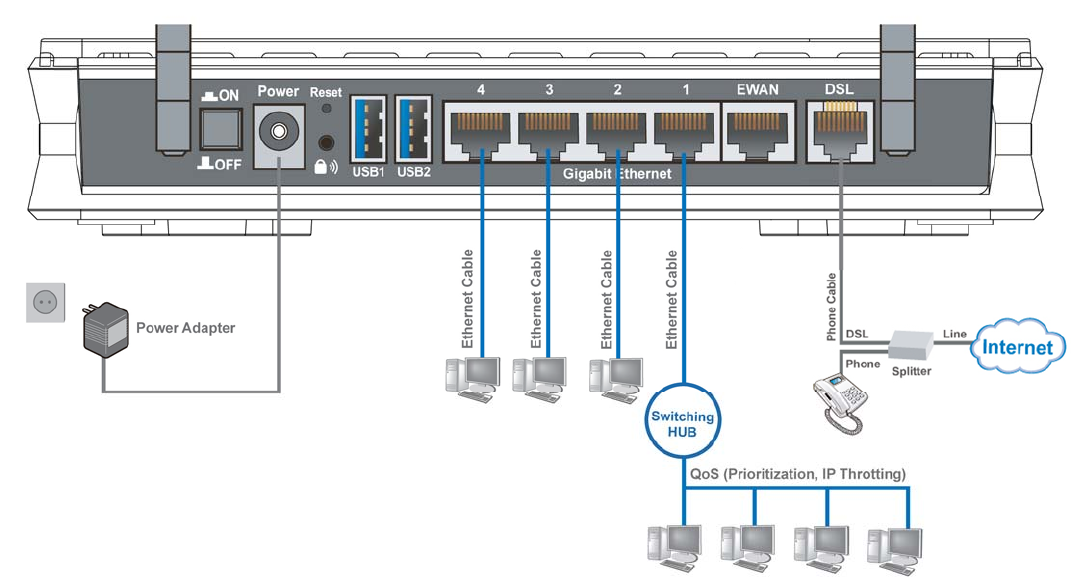
6
1.4 Applications for the BiPAC 7600NX(L)
BiPAC 7600NX(L) is a all-in-one router, supporting alternative ways (ADSL, EWAN) to connect to the Internet.
Then users can choose one of the ways to connect to the Internet or ISP.
ADSL router mode
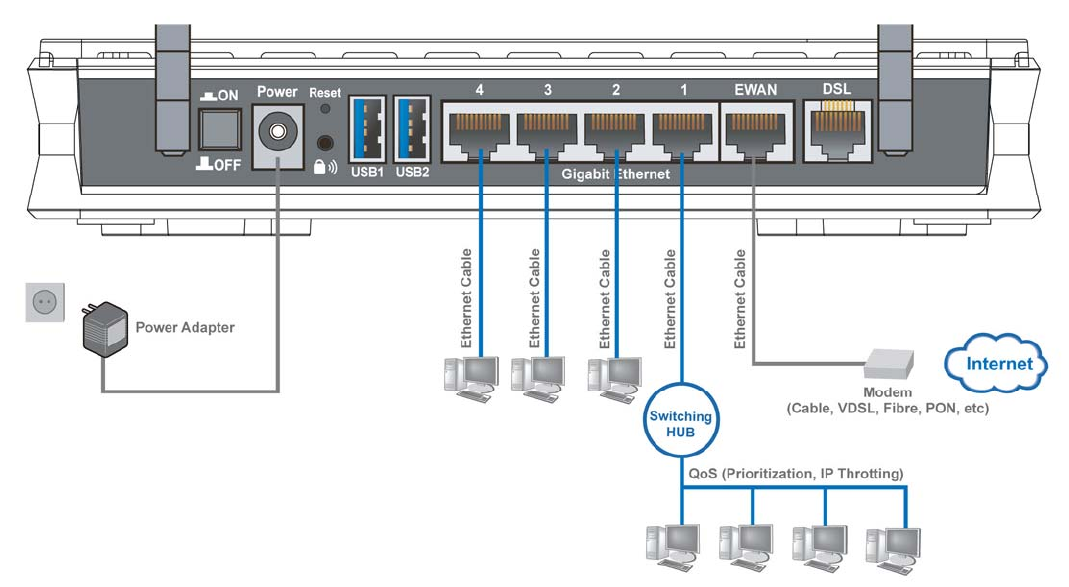
6
Broadband router mode

7
Chapter 2
Installing the BiPAC 7600NX(L)
2.1 Important note for using the BiPAC 7600NX(L)
Place the BiPAC 7600NX(L) on a stable surface.
Only use the power adapter that comes with the package. Using a
different voltage rating power adaptor may damage the router.
Attention
Do not use the BiPAC 7600NX(L) in high humidity or high
temperatures.
Do not use the same power source for the BiPAC 7600NX(L) as
other equipment.
Do not open or repair the case yourself. If the BiPAC 7600NX(L) is
too hot, turn off the power immediately and have it repaired at a
qualified service center.
Avoid using this product and all accessories outdoors.
Warning
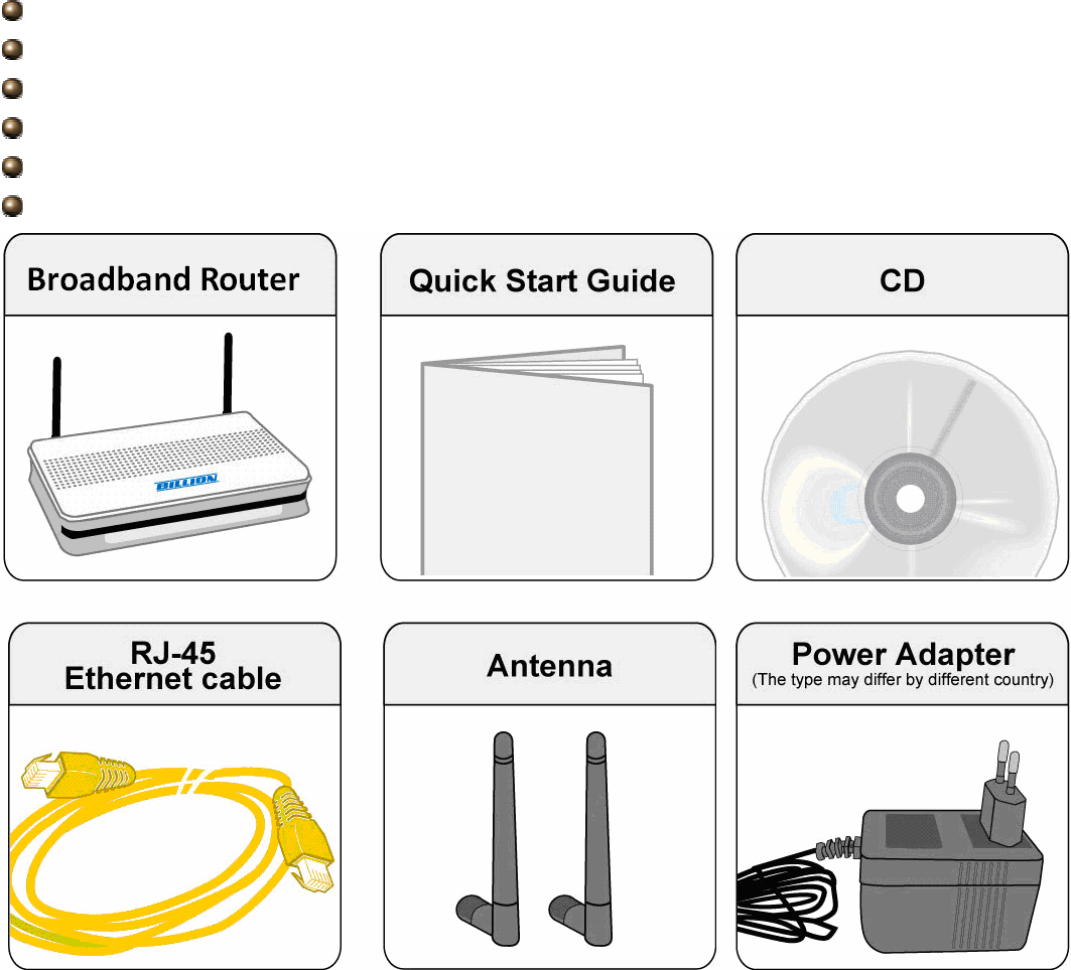
8
2.2 Package Contents
BiPAC 7600NX(L) Gigabit Wireless (VPN) ADSl2+ router
CD containing user manual
Ethernet (CAT-5 LAN) cable
Power adapter
Quick Start Guide
Two 2dBi detachable Antennas

9
2.3 The Front LEDs
LED Status Meaning
Red Router powered on
1 Power
Green System ready
Green Transmission speed hitting 1000Mbps
Orange Transmission speed hitting 10/100Mbps
2 EWAN
Blinking Data being transmitted/received
Green Transmission speed hitting 1000Mbps
Orange Transmission speed hitting 10/100Mbps
3 Ethernet Port 1-4
Blinking Data being transmitted/received
4 USB1-2 Green Connected to a storage device
Green Wireless connection established
5 Wireless
Green blinking Sending/receiving data
Green blinking WPS configuration being in progress
Lit up brightly and
then goes off in 5
seconds
WPS established
6 WPS
Flash for 2 mins
and then goes off WPS establishment failure
Green blinking Waiting for ADSL synchronization
7 DSL
Green Successfully connected to an ADSL line
Red Obtaining IP failure
Green Having obtained an IP address successfully
8 Internet
Off Router in bridged mode or WAN connection not present.
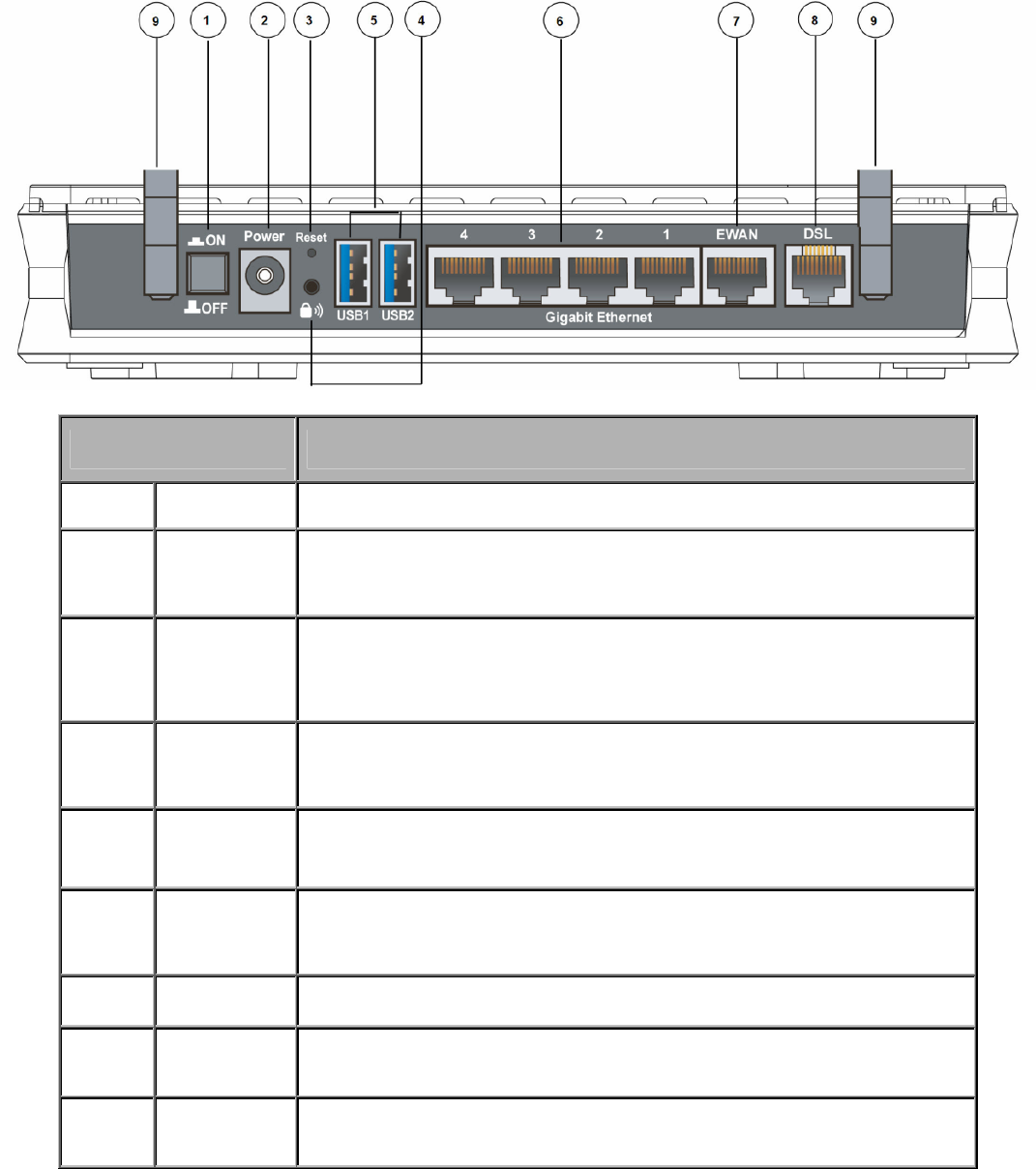
10
2.4 The Rear Ports
Port Meaning
1 Power Connect the supplied power adapter to this jack.
2 Power Switch Power ON/OFF switch
3 RESET After the device is powered on, press it 6 seconds or above: to restore to factory
default settings (this is used when you can not login to the router, e.g. forgot the
password)
4 WPS Push WPS button to trigger Wi-Fi Protected Setup function.
5 USB Connect the storage device to this port.
6 Ethernet Connect a UTP Ethernet cable (Cat-5 or Cat-5e) to one of the four LAN ports when
connecting to a PC or an office/home network of 10Mbps or 100Mbps.
7 EWAN Connect to Cable Modem, Fiber Modem or PON optic lines with your RJ-45 cable.
8 DSL Connect this port to the DSL network with the RJ-11 cable (telephone) provided.
9 Antenna Connect the detachable antenna to this port.

11
The detail instruction in Reset Button
Recovery procedures for non-working routers (e.g. after a failed firmware upgrade flash):
Power on the router, once the Power LED lit red, please press this reset button using the end of paper clip or
other small pointed object immediately.
The router’s emergency-reflash web interface will then be accessible via http://192.168.1.1 where you can
upload a firmware image to restore the router to a functional state.
Please note that the router will only respond with its web interface at this address (192.168.1.1), and will not
respond to ping request from your PC or other telnet operations.
Note:
Before starting recovery process, please configure the IP address of the PC as 192.168.1.100 and proceed with
the following step-by-step guide.
1. Power the router off.
2. Power on the router, once the Power lights Red, press reset button immediately.
3. Internet and DSL flashes Green, router entering recovery procedure and router's IP will reset to Emergency
IP address (Say 192.168.1.1)
4. Open IE and access http://192.168.1.1 to upload the firmware.
5. Internet lit Red and DSL lit off, and router starts to write firmware into flash. Please DO NOT power off the
router at this step.
6. Internet lit Green when successfully upgrade firmware.
7. Power the router off and then on.
2.6 Cabling
One of the most common causes of problems is bad cabling or xDSL line(s). Make sure that all connected
devices are turned on. On the front panel of the product is a bank of LEDs. Verify that the LAN Link and xDSL
line LEDs are lit. If they are not, verify that you are using the proper cables.
Make sure that all other devices (e.g. telephones, fax machines, analogue modems) connected to the same
telephone line as your Billion router have a line filter connected between them and the wall socket (unless you
are using a Central Splitter or Central Filter installed by a qualified and licensed electrician), and that all line
filters are correctly installed in a right way. If the line filter is not correctly installed and connected, it may cause
problems to your XDSl connection or may result in frequent disconnections.

12
Chapter 3
Basic Installation
The router can be configured with your web browser. A web browser is included as a standard application in the
following operating systems: Windows 98/NT/2000/XP/Vista/Win7, Linux, Mac OS, etc. The product provides
an easy and user-friendly interface for configuration.
3.1 Before Configuration
PCs must have an Ethernet interface installed properly and be connected to the router either directly or through
an external repeater hub, and have TCP/IP installed and configured to obtain an IP address through a DHCP
server or a fixed IP address that must be in the same subnet as the router. The default IP address of the router
is 192.168.1.254 and the subnet mask is 255.255.255.0 (i.e. any attached PC must be in the same subnet, and
have an IP address in the range of 192.168.1.1 to 192.168.1.253). The best and easiest way is to configure the
PC to get an IP address automatically from the router using DHCP. If you encounter any problems accessing the
router’s web interface it may also be advisable to uninstall any kind of software firewall on your PCs, as they
can cause problems accessing the 192.168.1.254 IP address of the router. Users should make their own
decisions on how to best protect their network.
Please follow the steps below for your PC’s network environment installation. First of all, please check your PC’s
network components. The TCP/IP protocol stack and Ethernet network adapter must be installed. If not, please
refer to your Windows-related or other operating system manuals.
Any TCP/IP capable workstation can be used to communicate with or
through the BiPAC 7600NX(L). To configure other types of workstations,
please consult the manufacturer’s documentation.
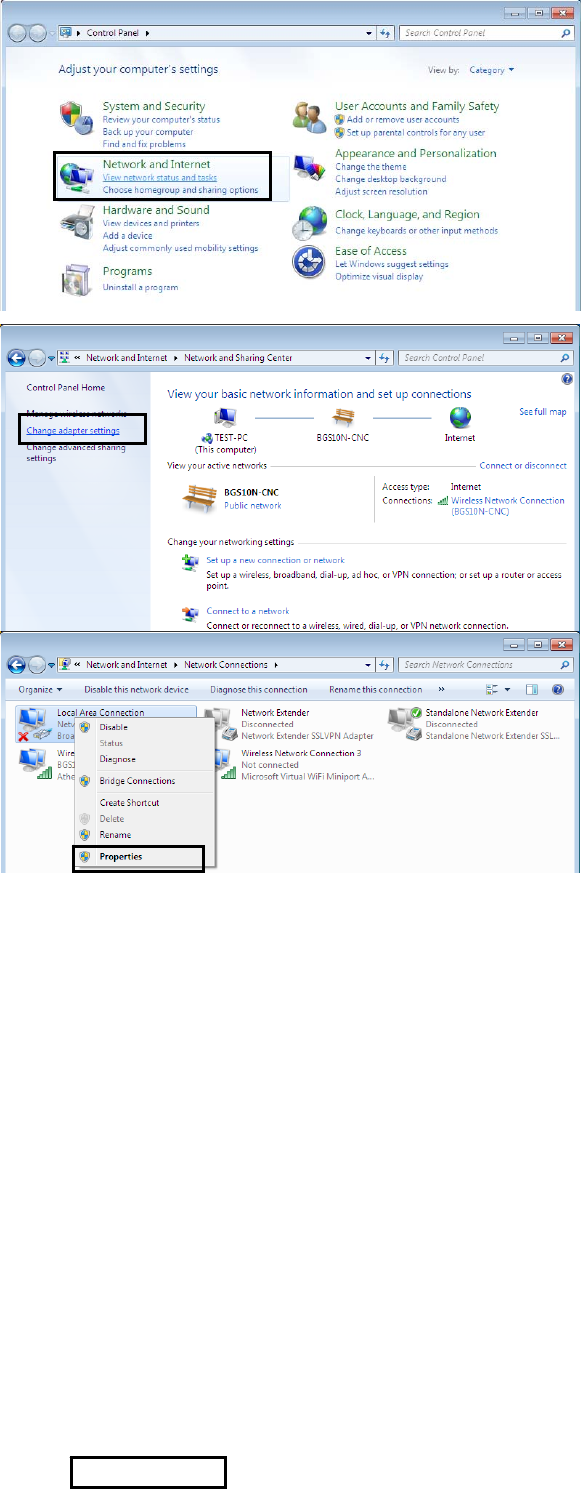
13
3.1.1 Configuring a PC in Windows 7
1. Go to Start. Click on Control
Panel.
Then click on Network and
Internet.
2. When the Network and
Sharing Center window pops
up, select and click on Change
adapter settings on the left
window panel.
3. Select the Local Area
Connection, and right click the
icon to select Properties.
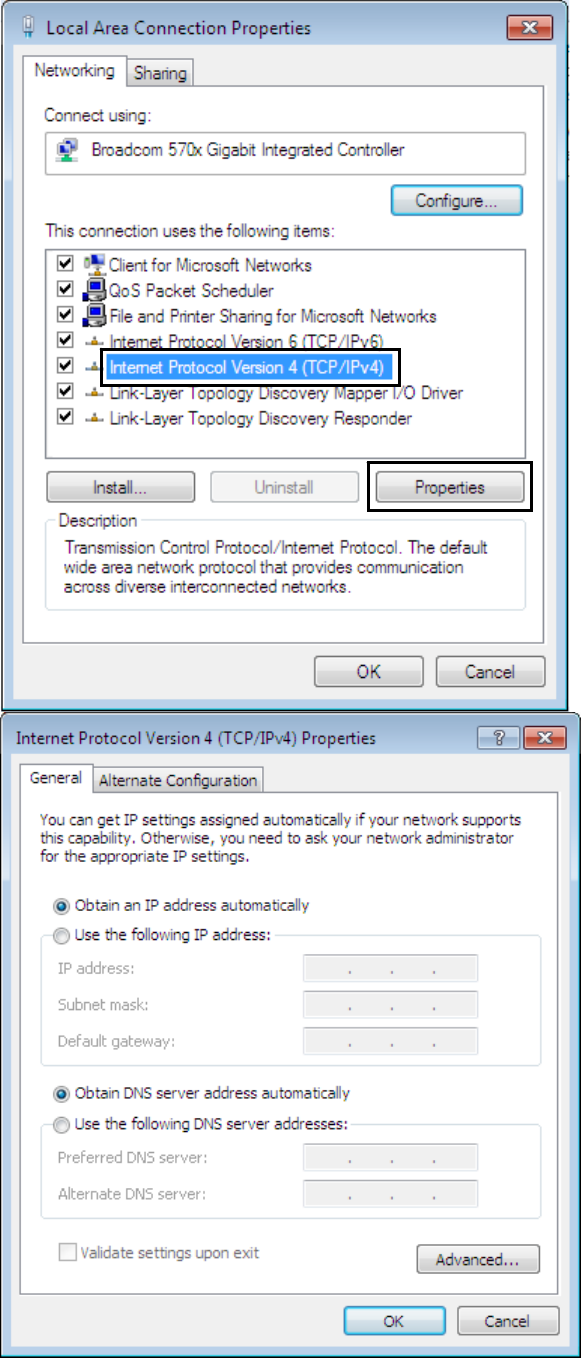
14
IPv4:
1) Select Internet Protocol
Version 4 (TCP/IPv4) then
click Properties
2) In the TCP/IPv4 properties
window, select the Obtain an IP
address automatically and
Obtain DNS Server address
automatically radio buttons.
Then click OK to exit the
setting.
3) Click OK again in the Local Area
Connection Properties
window to apply the new
configuration.
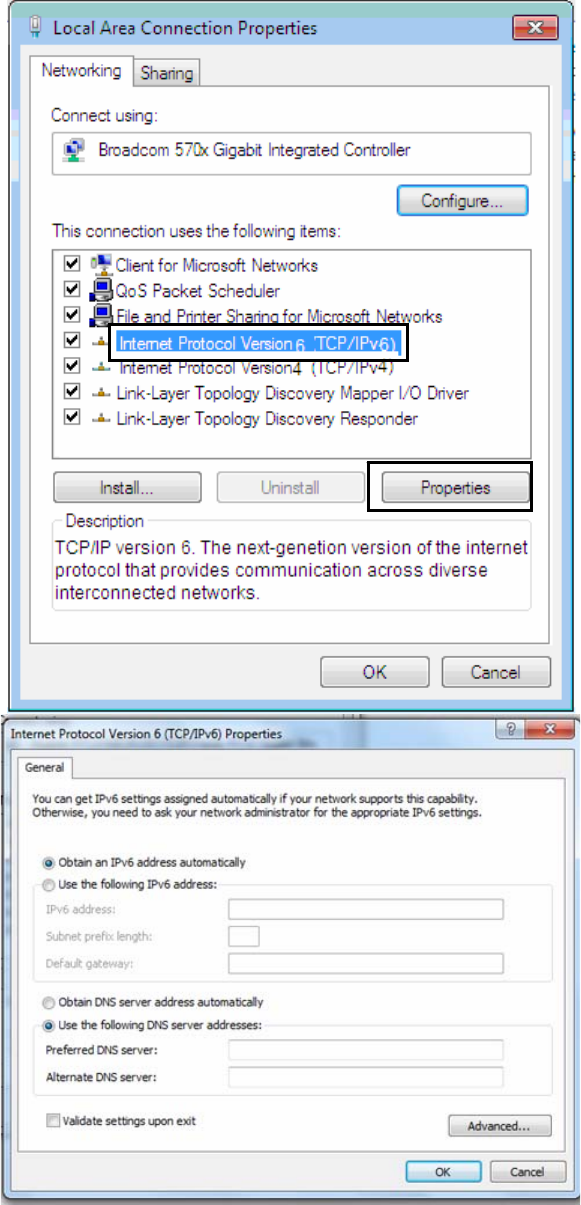
15
IPv6:
4. Select Internet Protocol
Version 6 (TCP/IPv6) then
click Properties
5. In the TCP/IPv6 properties
window, select the Obtain an
IPv6 address automatically
and Obtain DNS Server
address automatically radio
buttons. Then click OK to exit
the setting.
6. Click OK again in the Local
Area Connection Properties
window to apply the new
configuration.
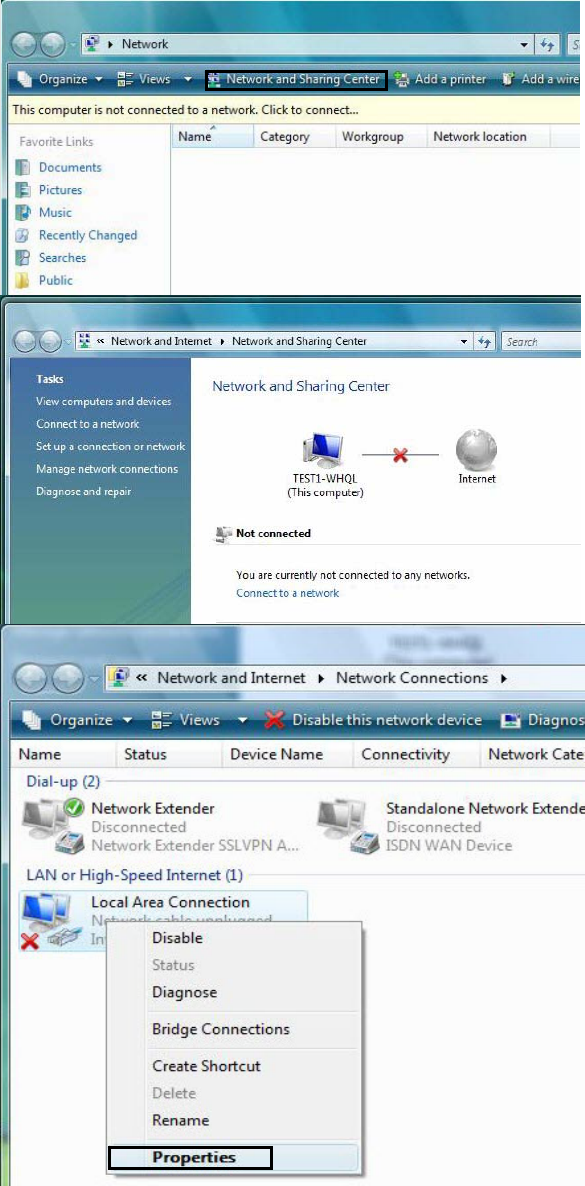
16
3.1.2 Configuring a PC in Windows Vista
1. Go to Start. Click on Network.
1. Then click on Network and
Sharing Center at the top bar.
2. When the Network and
Sharing Center window pops
up, select and click on Manage
network connections on the
left window pane.
3. Select the Local Area
Connection, and right click the
icon to select Properties.
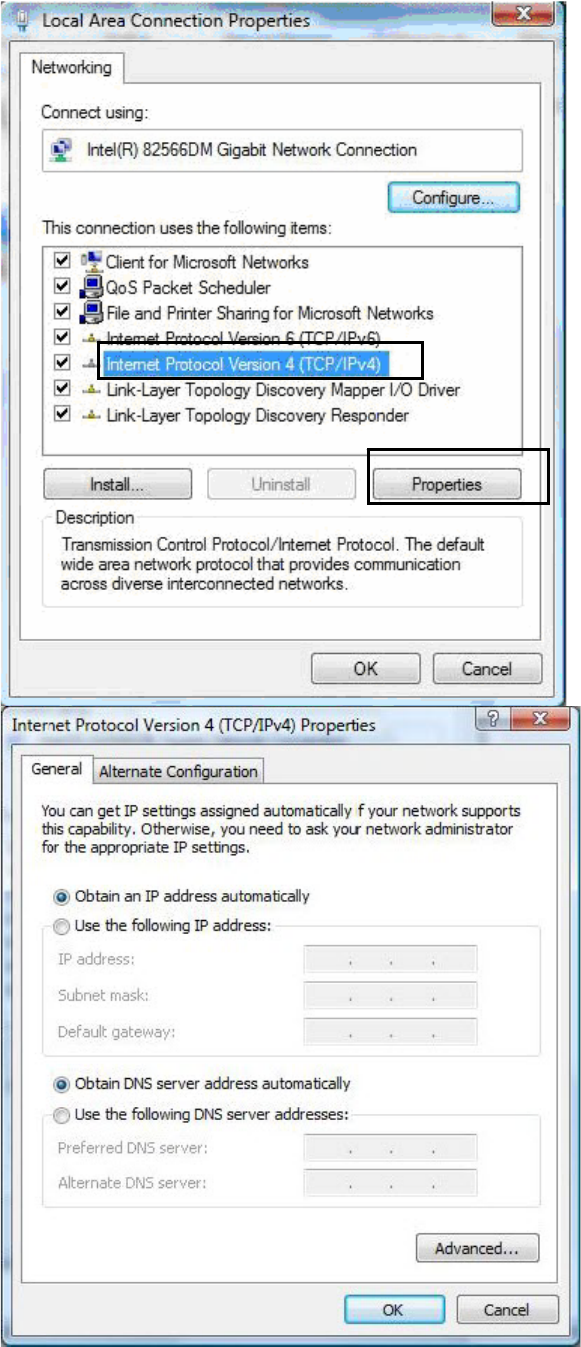
17
IPv4: 4. Select Internet Protocol
Version 4 (TCP/IPv4) then click
Properties.
5. In the TCP/IPv4 properties
window, select the Obtain an IP
address automatically and
Obtain DNS Server address
automatically radio buttons.
Then click OK to exit the setting.
6. Click OK again in the Local
Area Connection Properties
window to apply the new
configuration.
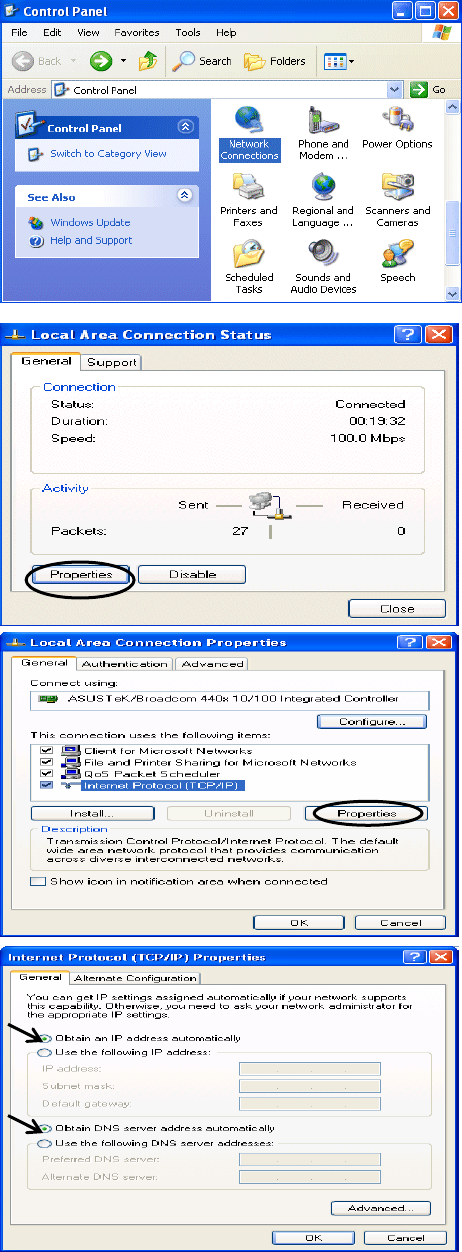
18
3.1.3 Configuring a PC in Windows XP
IPv4:
7. Go to Start / Control Panel (in Classic
View). In the Control Panel, double-click on
Network Connections
8. Double-click Local Area Connection.
9. In the Local Area Connection Status
window, click Properties.
10. Select Internet Protocol (TCP/IP) and click
Properties.
11. Select the Obtain an IP address
automatically and the Obtain DNS server
address automatically radio buttons.
12. Click OK to finish the configuration.
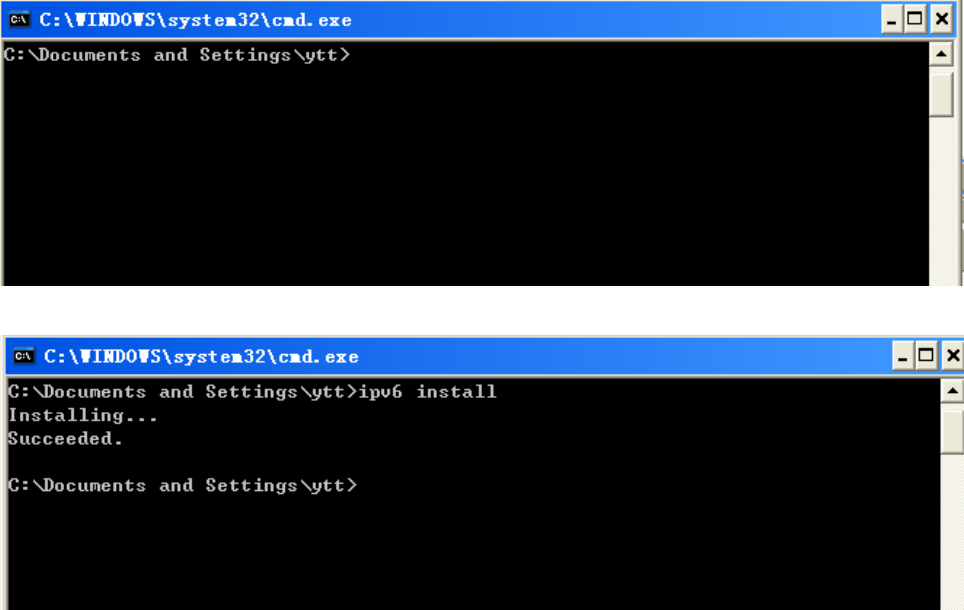
19
IPv6:
IPv6 is supported by Windows XP, but you should install it first.
Act as shown below:
1. On the desktop, Click Start > Run, type cmd, then press Enter key in the keyboard, the following screen
appears.
2. Key in command ipv6 install
Configuration is OK now, you can test whether it works ok.
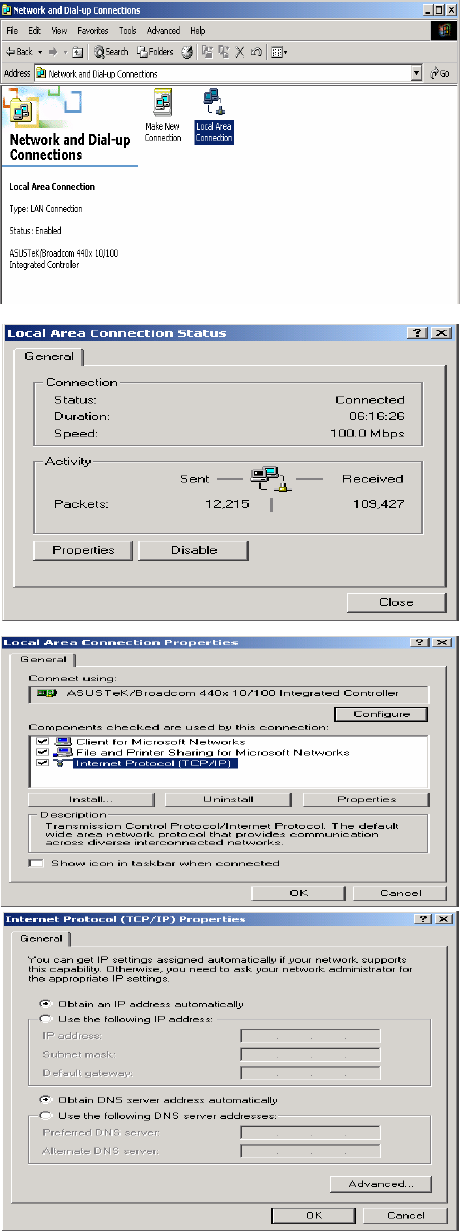
20
3.1.3 Configuring PC in Windows 2000
1. Go to Start / Settings / Control Panel. In
the Control Panel, double-click on Network
and Dial-up Connections.
2. Double-click Local Area Connection.
3. In the Local Area Connection Status
window click Properties.
4. Select Internet Protocol (TCP/IP) and click
Properties.
5. Select the Obtain an IP address
automatically and the Obtain DNS server
address automatically radio buttons.
6. Click OK to finish the configuration.
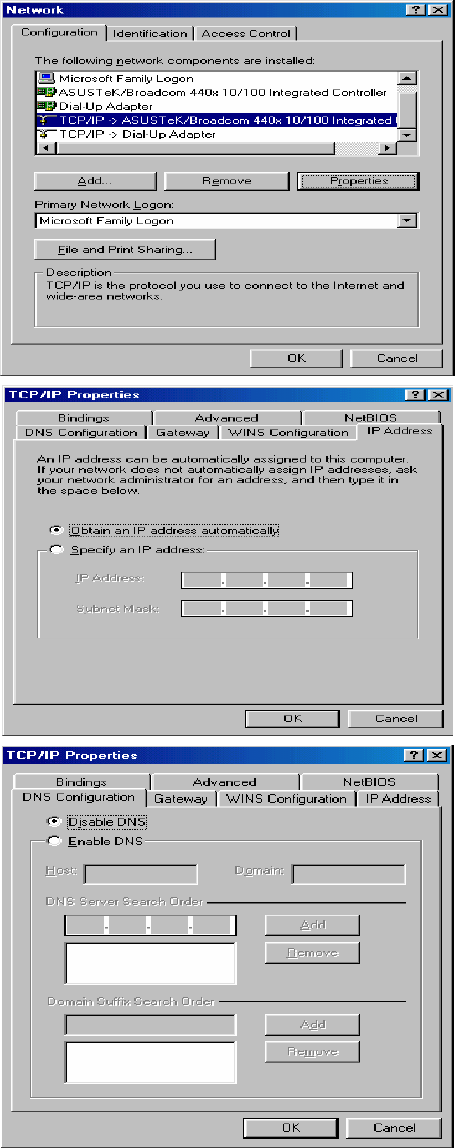
21
3.1.4 Configuring PC in Windows 98/Me
1. Go to Start / Settings / Control Panel. In
the Control Panel, double-click on Network
and choose the Configuration tab.
2. Select TCP/IP ->NE2000 Compatible, or
the name of your Network Interface Card
(NIC) in your PC.
3. Select the Obtain an IP address
automatically radio button.
4. Then select the DNS Configuration tab.
5. Select the Disable DNS radio button and
click OK to finish the configuration.
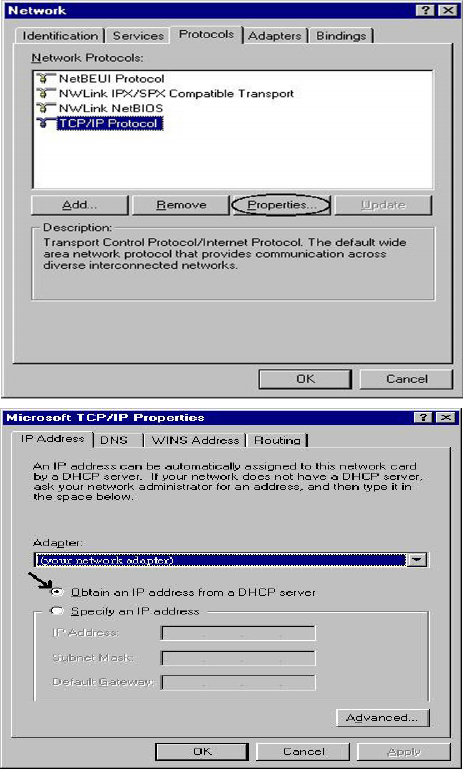
22
3.1.5 Configuring PC in Windows NT4.0
1. Go to Start / Settings / Control Panel. In
the Control Panel, double-click on Network
and choose the Protocols tab.
2. Select TCP/IP Protocol and click
Properties.
3. Select the Obtain an IP address from a
DHCP server radio button and click OK.

23
3.2 Factory Default Settings
Before configuring your router, you need to know the following default settings.
Web Interface:
Username: admin
Password: admin
LAN Device IP Settings:
IP Address: 192.168.1.254
Subnet Mask: 255.255.255.0
ISP setting in WAN site:
PPPoE
DHCP server:
DHCP server is enabled.
Start IP Address: 192.168.1.100
IP pool counts: 20
3.2.1 Username and Password
The default username and password are “admin” and “admin” respectively.
Attention
Attention
If you ever forget the password to log in, you may press the RESET button
up to 6 seconds to restore the factory default settings.

24
3.3 LAN and WAN Port Addresses
The parameters of LAN and WAN ports are pre-set in the factory. The default values are shown below.
IPv4:
LAN Port WAN Port
IP address 192.168.1.254
Subnet Mask 255.255.255.0
DHCP server function Enabled
IP addresses for
distribution to PCs 20 IP addresses continuing from
192.168.1.100 through 192.168.1.119
The PPPoE function is
enabled to automatically
get the WAN port
configuration from the
ISP.
3.4 Information from your ISP
Before configuring this device, you have to check with your ISP (Internet Service Provider) what kind of service
is provided such as ADSL (Dynamic IP Address, Static IP Address, PPPoE, PPPoA, Bridge Mode), EWAN
((Dynamic IP address, Static IP address, PPPoE, Bridge Mode).
Gather the information as illustrated in the following table and keep it for reference.
ADSL:
PPPoE VPI/VCI, VC-based/LLC-based multiplexing, Username, Password, Service Name,
and Domain Name System (DNS) IP address (it can be automatically assigned by
your ISP when you connect or be set manually).
PPPoA VPI/VCI, VC-based/LLC-based multiplexing, Username, Password, and Domain
Name System (DNS) IP address (it can be automatically assigned by your ISP
when you connect or be set manually).
RFC1483
Bridged IP
VPI/ VCI, LLC-based/ VC-based multiplexing, and Domain Name
System (DNS) IP address (it can be automatically assigned by your
ISP when you connect or be set manually).
Dynamic IP
Address
RFC1483
Routed IP
VPI/ VCI, LLC-based/ VC-based multiplexing, and Domain Name
System (DNS) IP address (it can be automatically assigned by your
ISP when you connect or be set manually).
RFC1483
Bridged IP
VPI/ VCI, LLC-based/ VC-based multiplexing, Static IP Address, IP
Subnet Mask, Gateway IP Address, and Domain Name System
(DNS) IP address.
Static IP
Address RFC1483
Routed IP
VPI/ VCI, LLC-based/ VC-based multiplexing, Static IP Address, IP
Subnet Mask, Gateway IP Address, and Domain Name System
(DNS) IP address.
Bridge Mode 1483 Bridged
Only VPI/ VCI, LLC-based/ VC-based multiplexing.

25
EWAN:
PPPoE Username, Password, Service Name, and Domain Name System (DNS) IP address
(it can be automatically assigned by your ISP when you connect or be set
manually).
Dynamic IP
Address Domain Name System (DNS) IP address (it can be automatically assigned by your
ISP when you connect or be set manually).
Static IP
Address Static IP Address, IP Subnet Mask, Gateway IP Address, and Domain Name
System (DNS) IP address.
Bridge Mode Pure bridge.
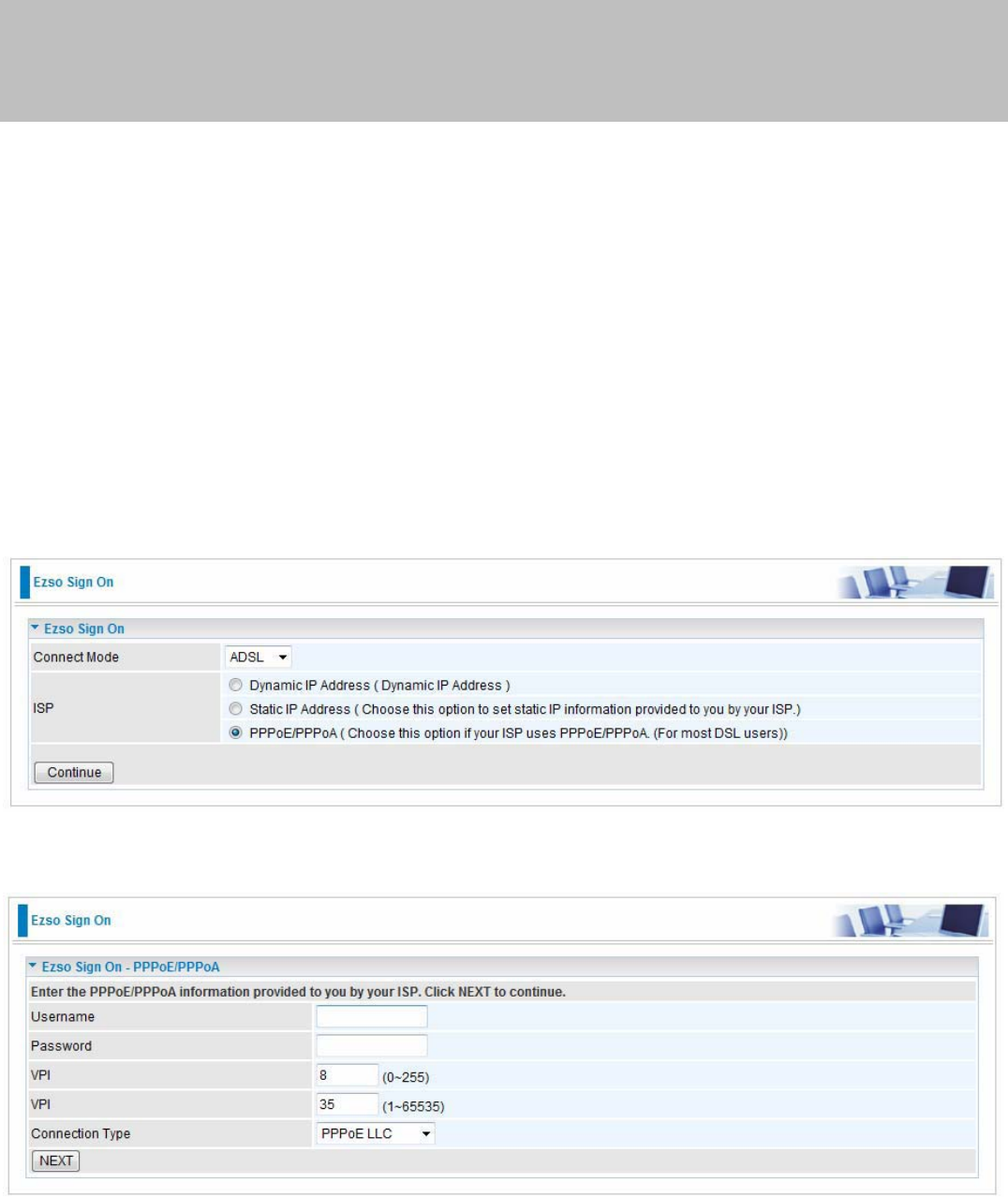
26
Chapter 4
Easy Sign-On (EZSO)
4.1 Easy Sign-On (EZSO)
This EZSO feature makes it easier for you to configure your router so that you can connect to the internet in a
couple of seconds without having to logon to the router's GUI for any detail configuration. This configuration
method is usually auto initiated if user is to connect to the internet via 7600NX(L).
When user try to access any internet access via 7600NX(L) (usually the first users of the router ), router would
take you to the EZSO configuration page without logon to the router's GUI.
ADSL
Step 1: Choose the ADSL connection mode. Press Continue to move on.
Step 2: Type the ADSL account, VCI/VPI from your ISP. Press NEXT to continue.
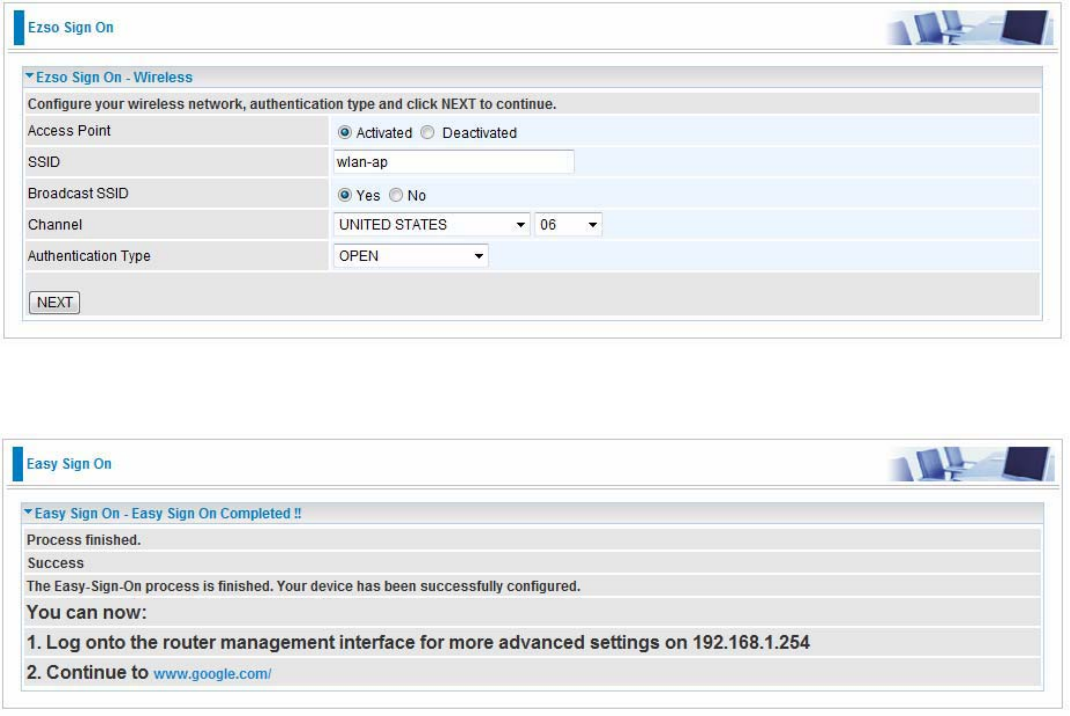
27
Step 3: Configure your wireless network. Press NEXT to continue.
Step 4: EZSO finished. (The default configuration is base on IPv4/IPv6)
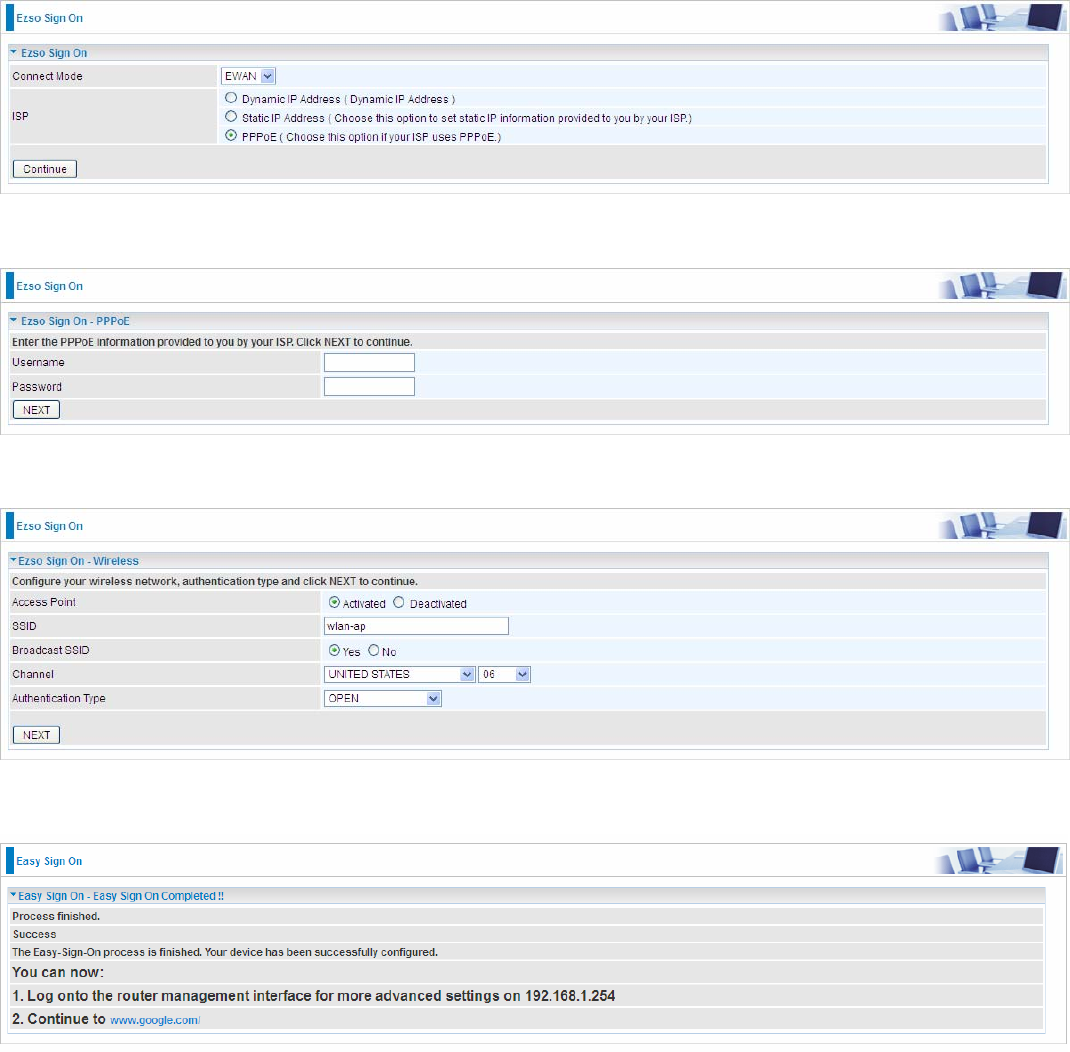
28
EWAN
Step 1: Choose the EWAN connection mode. Press Continue to move on.
Step 2: Enter the PPPoE account provided by your ISP. Press NEXT to continue.
Step 3: Configure your wireless network. Press NEXT to continue.
Step 4: EZSO finished. (The default configuration is base on IPv4/IPv6)
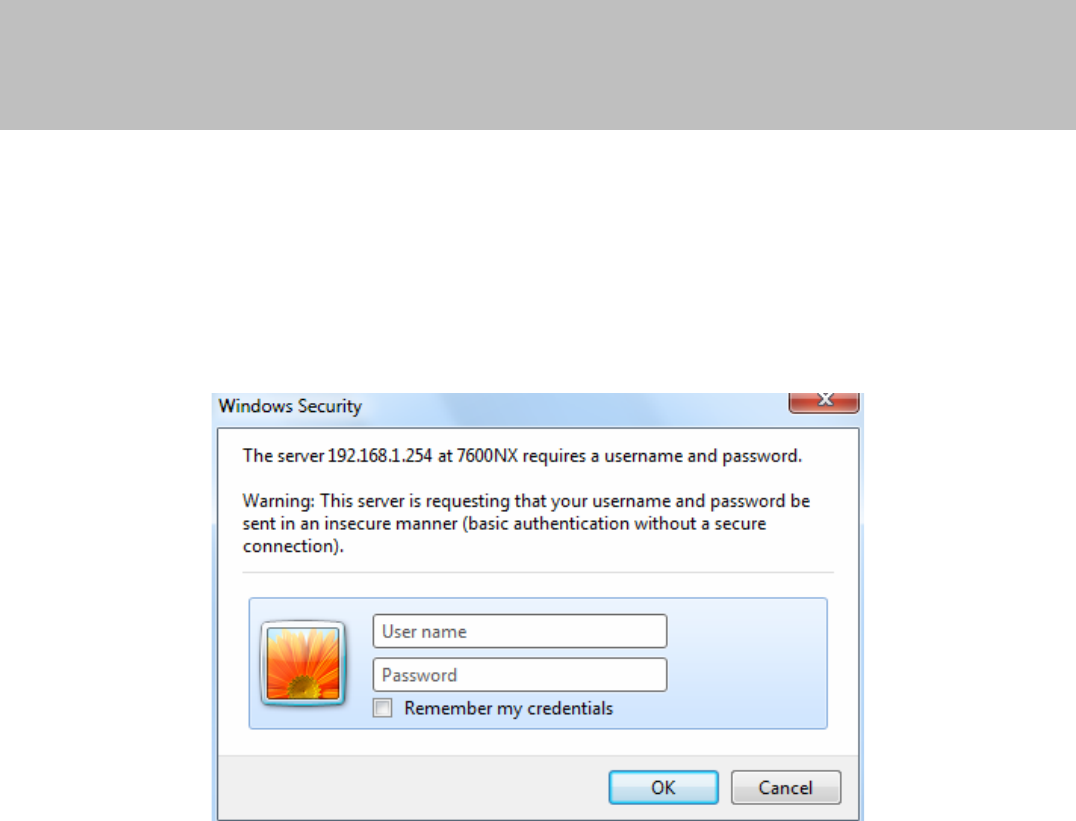
29
Chapter 5
Configuration
5.1 Configuring 7600NX(L) with your Web Browser
Open your web browser, enter the IP address of your router, which by default is 192.168.1.254, and click “OK”,
a user name and password window prompt will appear. The default username and password are “admin” and
“admin”.
Congratulation! You are now successfully logged on to the BiPAC 7600NX(L)!

30
At the configuration homepage, the left navigation pane where bookmarks are provided links you directly to the
desired setup page, including:
Status(Device Info, System Log, Statistics, DHCP Table, IPSec Status (7600NX only), PPTP Status (7600NX
only), Disk Status, L2TP Status (7600NX only))
Quick Start (Wizard Setup)
Configuration (Interface Setup, Dual WAN, Advanced Setup, Access Management, Maintenance)
Language
Please see the relevant sections of this manual for detailed instructions on how to configure your Billion router.
31
5.2 Status
In this section,you can check the router working status, including Device Info, System Log, Statistics, DHCP
Table, IPSEC Status (7600NX only), PPTP Status (7600NX only), Disk Status, and L2TP Status (7600NX
only).
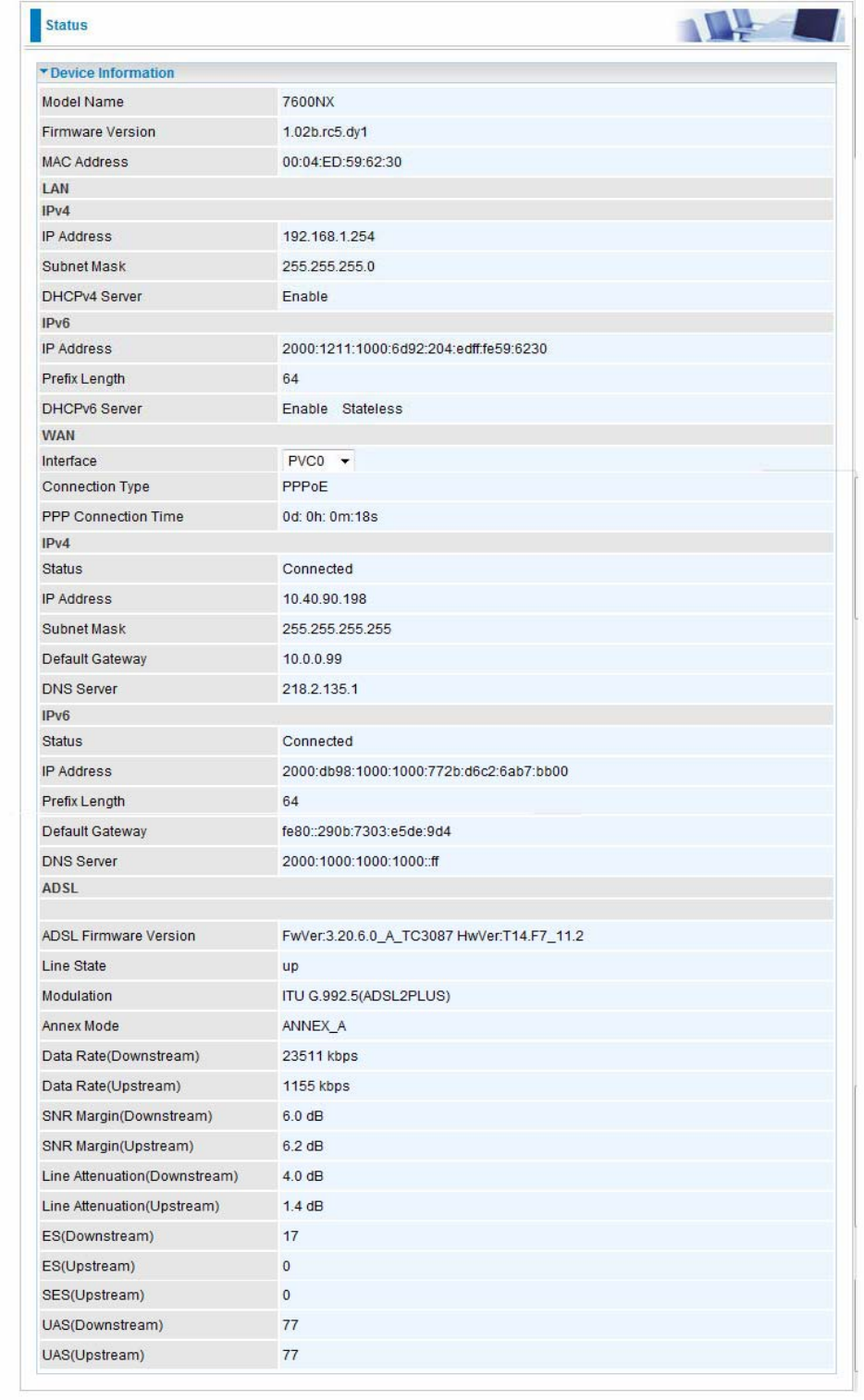
32
5.2.1 Device Info

33
Device Information
Firmware Version: This is the Firmware version
MAC Address: This is the MAC Address
Model Name: Show model name of the router
LAN
IPv4:
IP Address: LAN port IPv4 address.
Sub Net Mask: LAN port IP subnet mask.
DHCP Server: LAN port DHCP role - Enabled, Relay or disabled
IPv6:
IP Address: LAN port IPv6 address.
Prefix Length: The prefix length
DHCP Server: The DHCP status.
WAN
Interface: The now used connection method, PVC0-PVC7, EWAN.
Connection Type: The protocol selected.
PPPoE connection Time: The time totaled since it has been successfully connected.
IPv4:
Status: the connection status, Not connected or Connected.
IP Address: WAN port IP address.
Subnet Mask: WAN port IP subnet mask.
Default Gateway: The IP address of the default gateway.
DNS Server: WAN port DHCP role - Enabled, Relay or disabled
IPv6:
Status: the IPv6 connection status.
IP Address: WAN port IPv6 address.
Prefix Length: The prefix length..
Default Gateway: The IP address of the default gateway.
DNS Server: DNS information.
ADSL
ADSL Firmware Version: This is the DSL firmware version associated with your router
Line State: This is the status of your ADSL link, up or down.
Modulation: This field displays the ADSL modulation status for G.dmt or T1.413.
Annex Mode: To show the router’s type, e.g. Annex A, Annex B
SNR Margin: To show the router’s SNR margin for Downstream/Upstream
Line Attenuation: To show the router’s for Downstream/Upstream
34
Data Rate: To show the router’s data rate for Downstream/Upstream
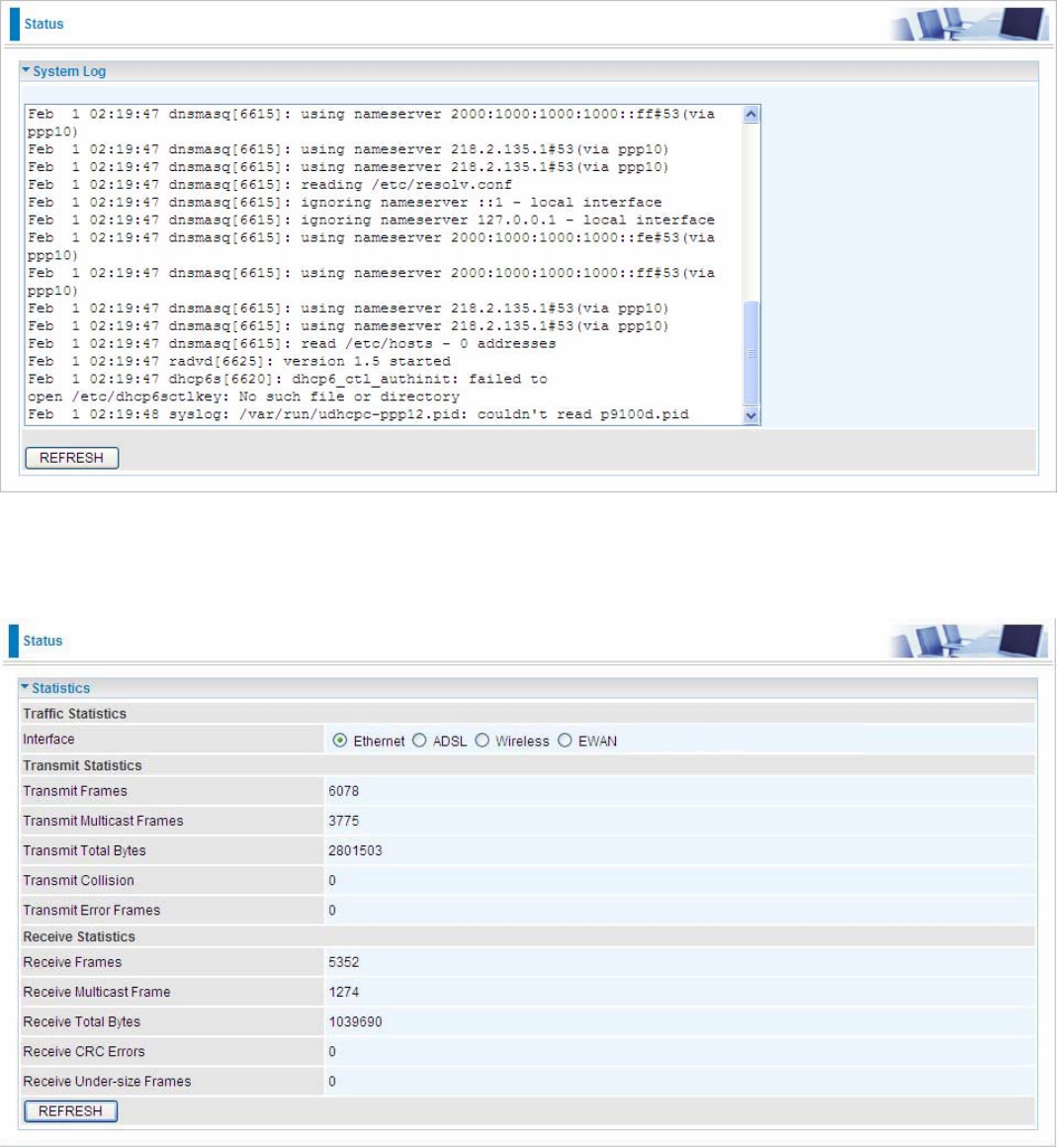
35
5.2.2 System Log
In system log, users can check the operations to the router and track the glitches to the router when occurred.
5.2.3 Statistics
Ethernet
Interface: This field displays the type of port
Transmit Frames: This field displays the number of frames transmitted until the latest second.
Transmit Multicast Frames: This field displays the number of multicast frames transmitted until the latest
second.
Transmit total Bytes: This field displays the number of bytes transmitted until the latest second.
Transmit Collision: This is the number of collisions on this port.
Transmit Error Frames: This field displays the number of error packets on this port.
Receive Frames: This field displays the number of frames received until the latest second.
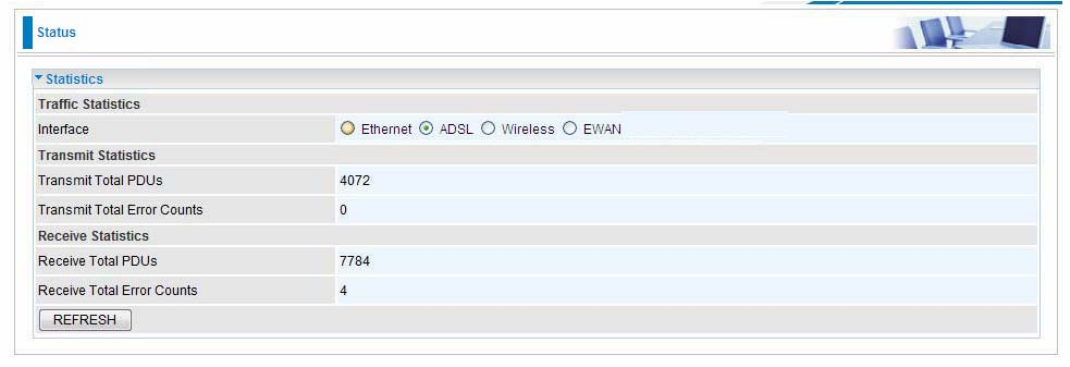
36
Receive Multicast Frames: This field displays the number of multicast frames received until the latest second.
Receive total Bytes: This field displays the number of bytes received until the latest second.
Receive CRC Errors: This field displays the number of error packets on this port.
Receive Under-size Frames: This field displays the number of under-size frames received until the latest
second.
REFRESH: Press this button to refresh the statistics.
ADSL
Transmit total PDUs: This field displays the number of total PDU transmitted until the latest second.
Transmit total Error Counts: This field displays the number of total error transmitted until the latest second.
Receive total PDUs: This field displays the number of total PDU received until the latest second.
Receive total Error Counts: This field displays the number of total error received until the latest second.
REFRESH: Press this button to refresh the statistics.
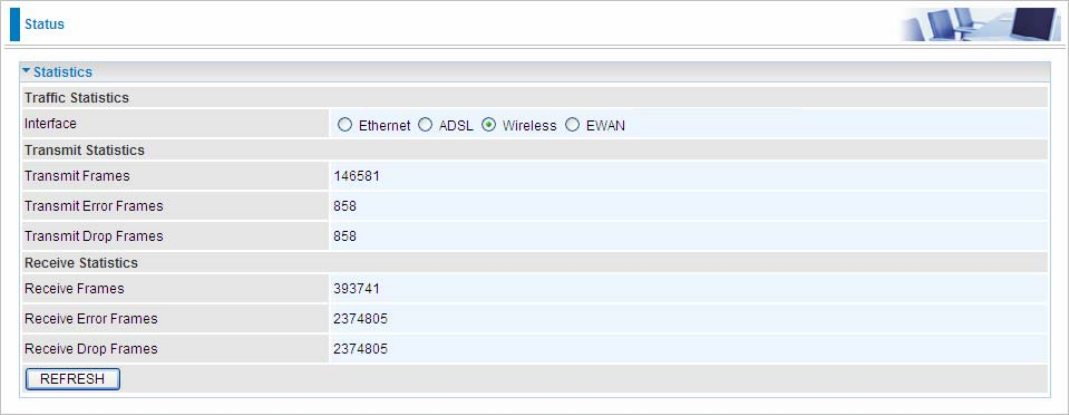
37
Wireless
Tx Frames Count: This field displays the number of frames transmitted until the latest second.
Tx Errors Count: This field displays the number of errors frames transmitted until the latest second.
Tx Drops Count: This field displays the number of drops frames transmitted until the latest second.
Rx Frames Count: This field displays the number of frames received until the latest second.
Rx Errors Count: This field displays the number of errors frames received until the latest second.
Rx Drops Count: This field displays the number of drops frames received until the latest second.
REFRESH: Press this button to refresh the statistics.
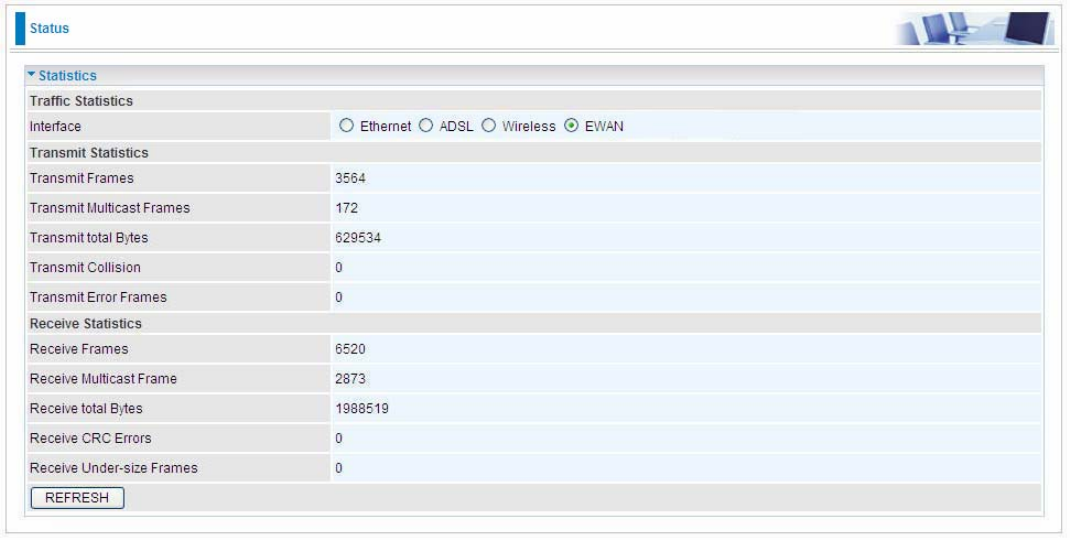
38
EWAN
Transmit Frames: This field displays the total number of frames transmitted until the latest second.
Transmit Multicast Frames: This field displays the total number of multicast frames transmitted till the latest
second.
Transmit total Bytes: This field displays the total number of bytes transmitted until the latest second.
Transmit Collision: This is the number of collisions on this port.
Transmit Error Frames: This field displays the number of error packets on this port.
Receive Frames: This field displays the number of frames received until the latest second.
Receive Multicast Frames: This field displays the number of multicast frames received until the latest second.
Receive total Bytes: This field displays the number of bytes received until the latest second.
Receive CRC Errors: This field displays the number of error packets on this port.
Receive Under-size Frames: This field displays the number of under-size frames received until the latest
second.
REFRESH: Press this button to refresh the statistics.
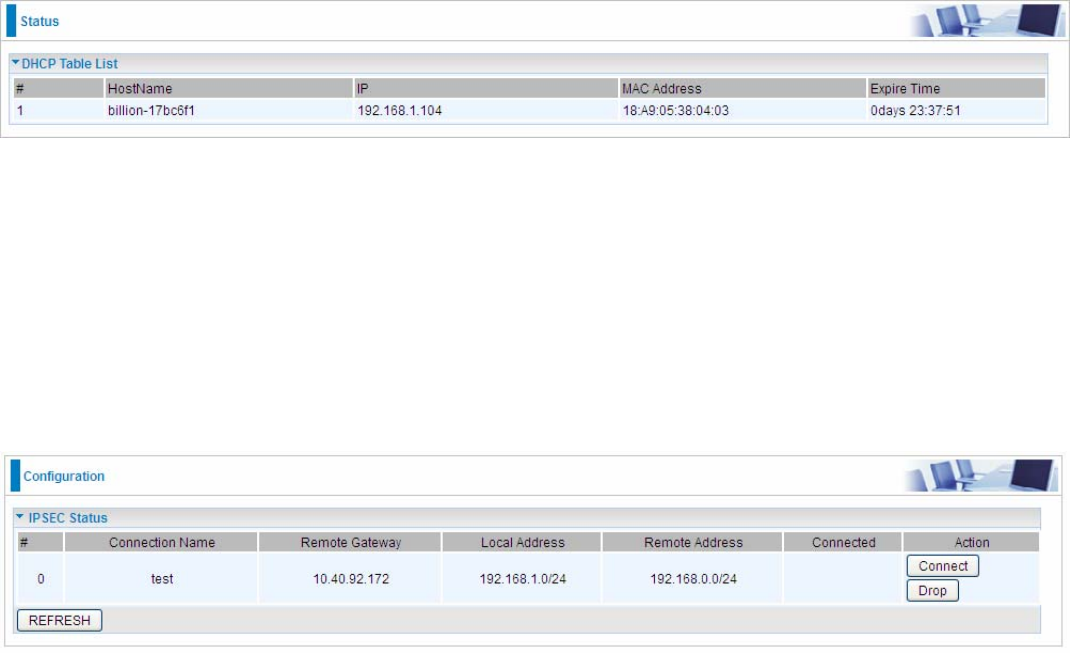
39
5.2.4 DHCP Table
DHCP table displays the devices connected to the router with clare information.
#: The index identifying the connected devices.
HostName: Show the hostname of the PC.
IP: The IP allocated to the device.
MAC Address: The MAC of the connected device.
Expire Time: The total remaining interval since the IP assignment to the PC.
5.2.5 IPSEC Status (7600NX only)
#: The IPSec entry index number.
Connection Name: User-defined IPSEC VPN connection name.
Remote Gateway: The IP of the remote gateway.
Local Address: The IP and netmask of local IPSEC gateway.
Remote address: The IP and netmask of remote IPSEC gateway.
Connected: Show the connecting status.
Action: Connection or Drop the connection.

40
5.2.6 PPTP Status (7600NX only)
PPTP Client
User: Four users(sessions) for client sessions. Here shows the using user.
Connection Name: Show user-defined PPTP VPN connection name.
Active: Show if the tunnel is active for connection.
Connection Type: Remote Access or LAN to LAN.
Server IP: Show the IP of VPN Server.
Peer Network IP: Display the remote network and subnet mask in LAN to LAN PPTP connection.
NetmasK: Show the netmask of peer network.
Connected: Show the connecting status.
PPTP Server
User: Four users (sessions) for server sessions. Here shows the using user.
Connection Name: Show user-defined PPTP VPN connection name.
Active: Show if the tunnel is active for connection.
Connection Type: Remote Access or LAN to LAN.
Assigned IP: Show the IP assigned to the client.
Peer Network IP: Display the remote network and subnet mask in LAN to LAN PPTP connection.
NetmasK: Show the netmask of peer network.
Connected: Show the connecting status.
Refresh: Click this button to refresh the connection status.
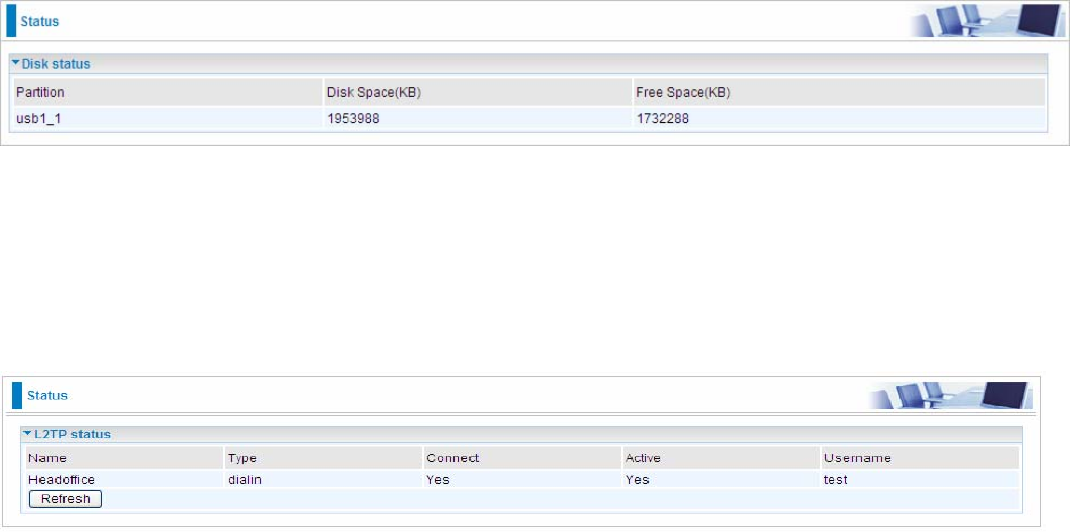
41
5.2.7 Disk Status
Partition: Display the NAS partition.
Disk Space(KB): Display the total storage space of the NAS in KB unit.
Free Space(KB): Display the available space in KB unit.
5.2.8 L2TP Status(7600NX only)
Name: Display the user-defined L2TP connection name.
Type: The VPN mode: dialin or dialout.
Connect: The connecting status.
Active: Show if the L2TP tunnel is active for connection.
Username: The user assigned to client (dialout use) or the user set for client to connect in (dialin use).
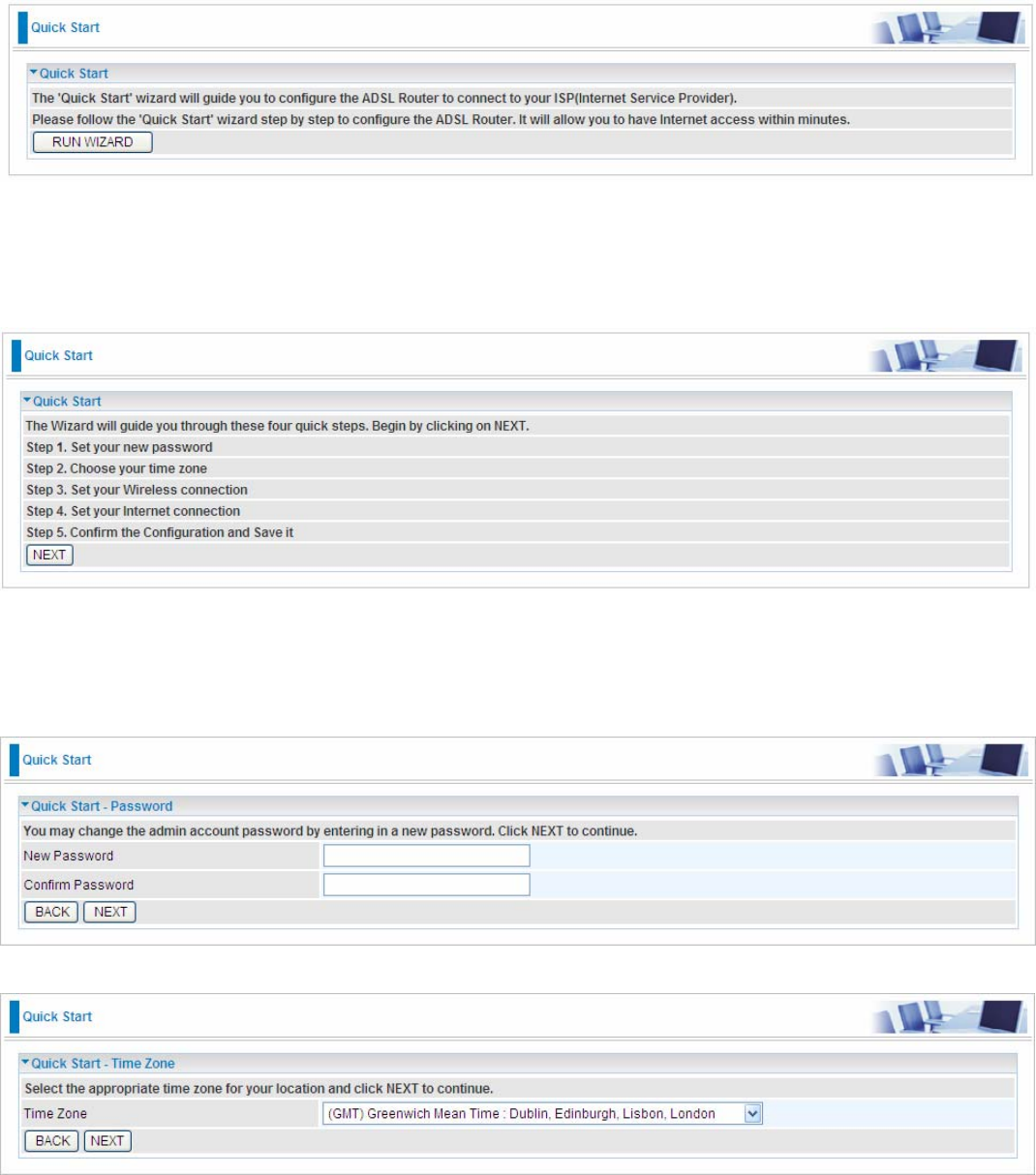
42
5.3 Quick Start
For detailed instructions on configuring WAN settings, see the Interface Setup section of this manual.
The Quick Start Wizard is a useful and easy utility to help setup the device to quickly connect to your ISP
(Internet Service Provider) with only a few steps required. It will guide you step by step to configure the
password, time zone, and WAN settings of your device. The Quick Start Wizard is a helpful guide for first time
users to the device.
Click NEXT to enter step 1.
Step1. Set new password of the “admin” account. The password was used to manage the web access. The
default is “admin”. Once changed, please remember carefully. Click NEXT to continue.
Step2: Choose your time zone. Click NEXT to continue.

43
Step3: Set your wireless connection. Click NEXT to continue.
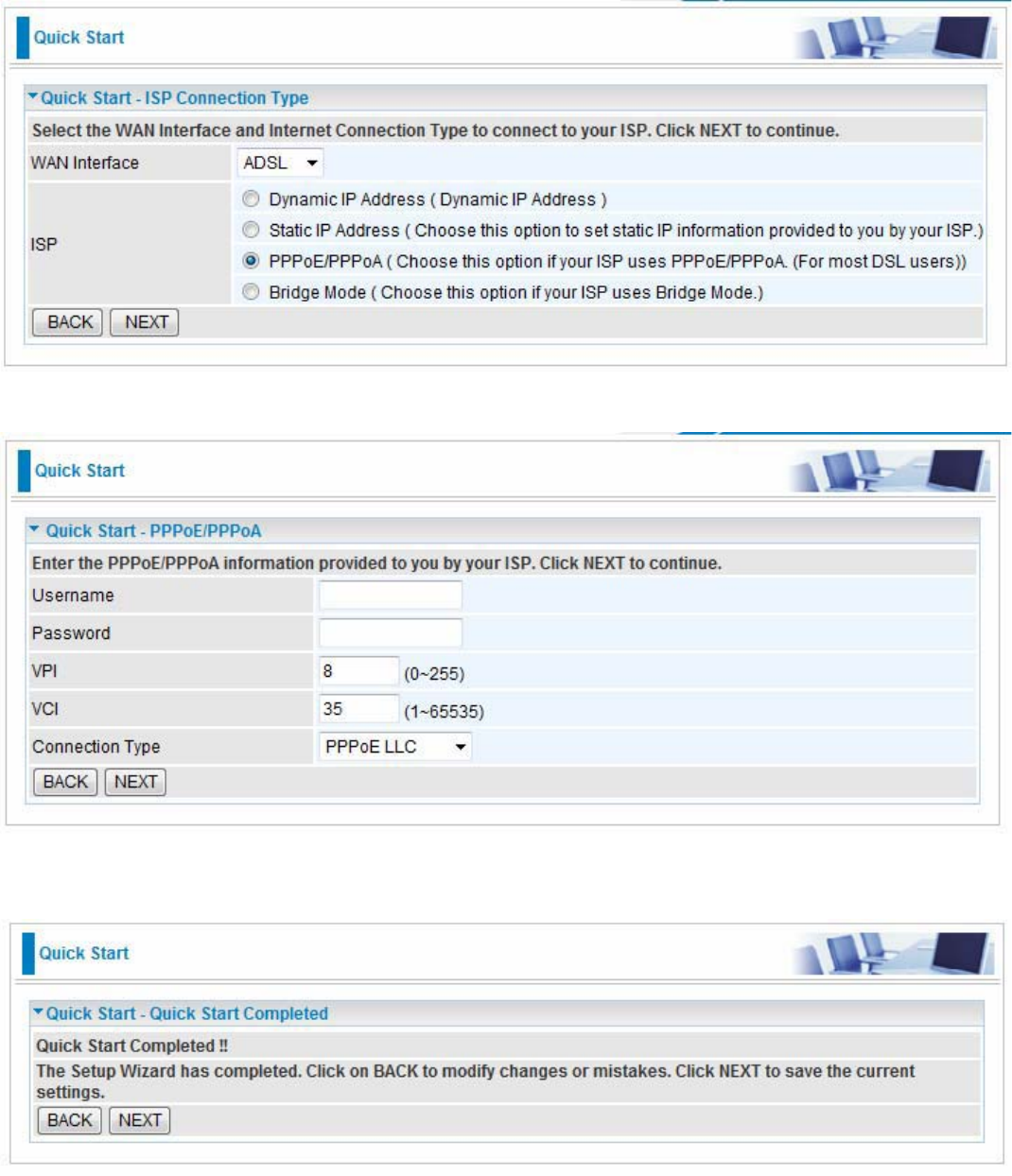
44
Step4: Set your Internet connection
WAN Transfer Modes: ADSL, or EWAN.
ADSL
1) Enter the PPPoE/PPPoA account / VPI,VCI information provided to you by your ISP. Click NEXT to continue.
2).The Setup Wizard has completed. Click on BACK to modify changes or mistakes. Click NEXT to save the
current settings.
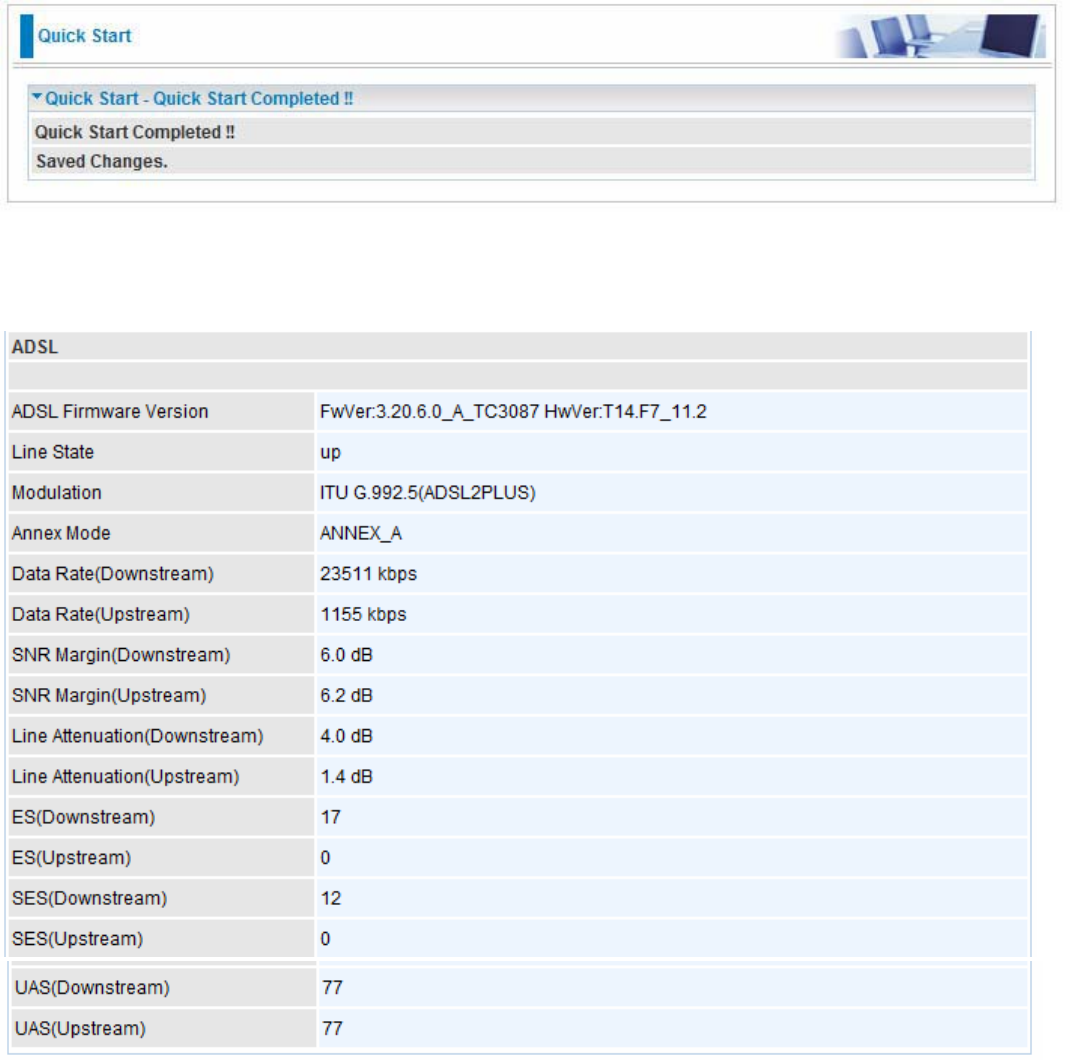
45
3). Quick Start Completed!
Note:
Please make sure the ADSL have synchronized, users can go to Status > Device Info to check instant information.
If the ADSL have synchronized, you can see information like shown in the following screenshot.
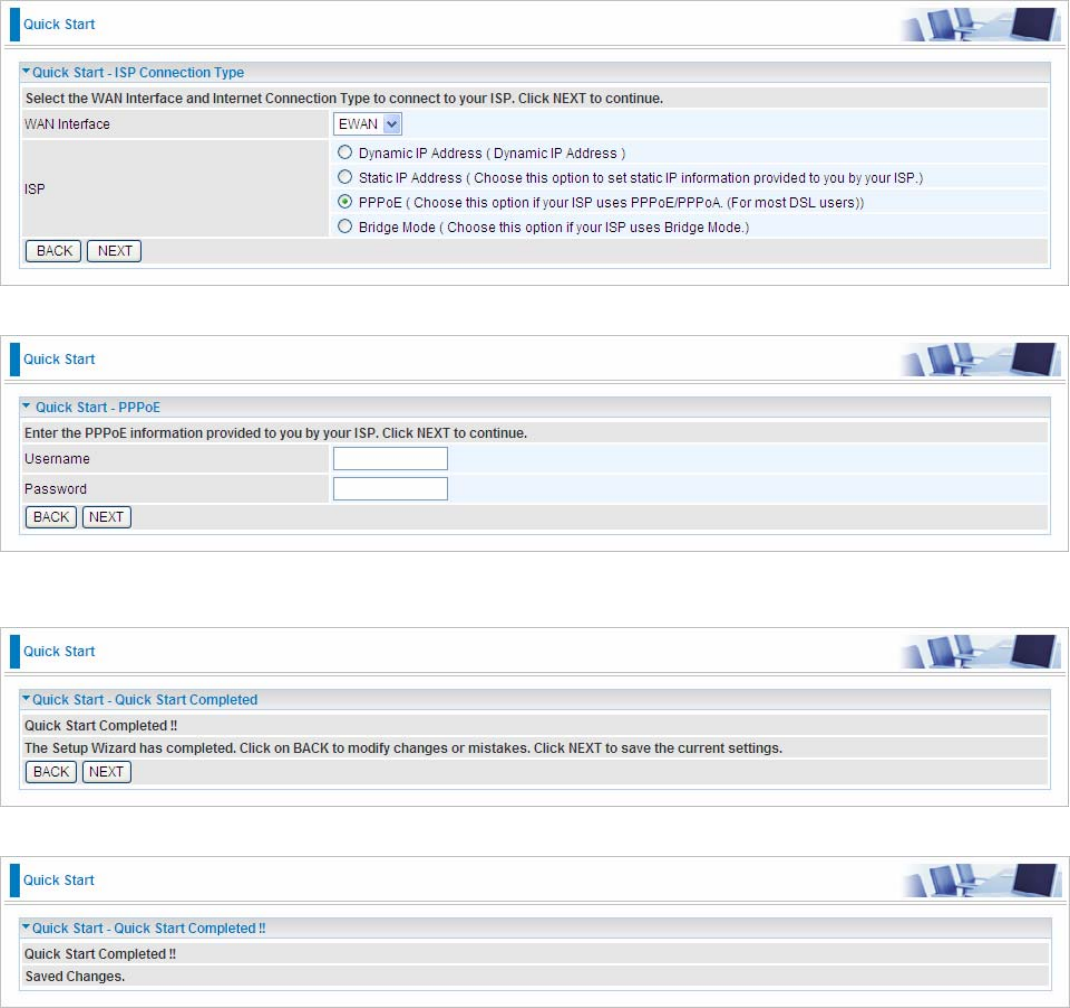
46
EWAN
1) .Select EWAN. Refer to your ISP to choose the appropriate connection protocol. Click NEXT to continue.
2) Enter the PPPoE account information provided to you by your ISP. Click NEXT to continue.
2).The Setup Wizard has completed. Click on BACK to modify changes or mistakes. Click NEXT to save the
current settings.
3). Quick Start Completed!
Switch to Status > Devic Info to view the status.
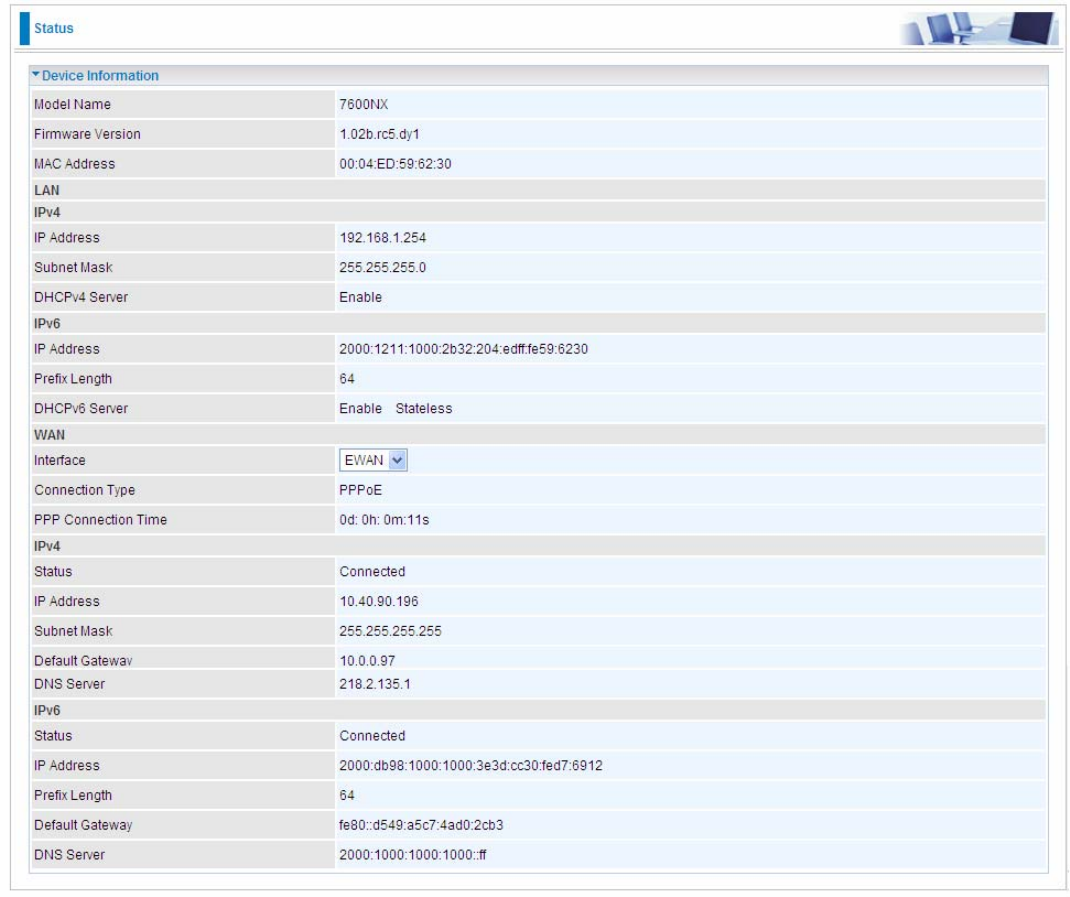
47
If configuration is completed, users can change to Status > Device Info for information.
48
5.4 Configuration
Click this item to access the following sub-items that configure the router: Interface Setup, Advanced Setup,
Access Management, and Maintenance.
First, let us take a look at the Interface Setup. There are three items contained in this section, namely, Internet,
LAN, and Wireless.
Each is described in the following scenario.
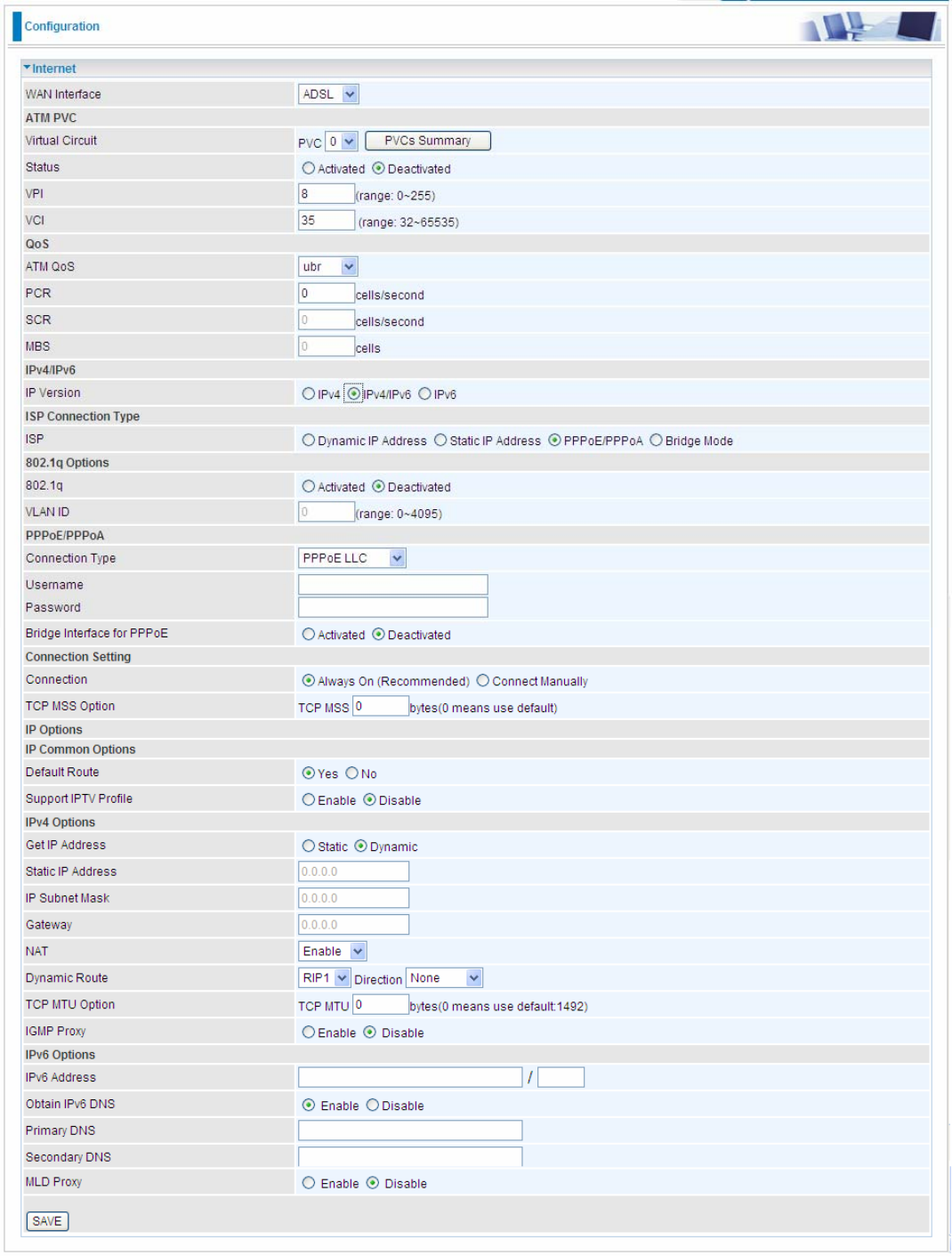
49
5.4.1 Interface Setup
5.4.1.1 Internet
ADSL
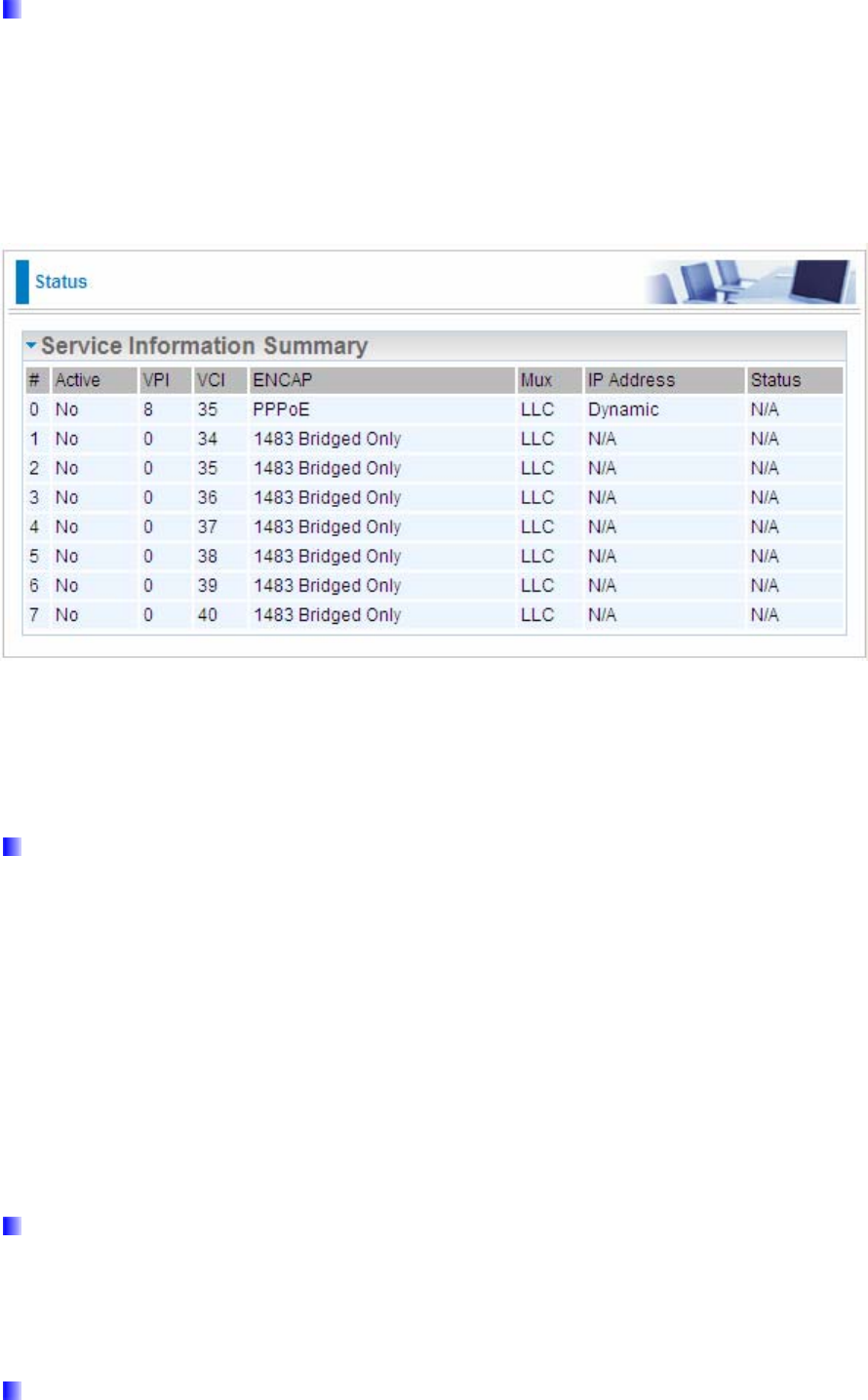
50
ATM PVC
ATM settings are used to connect to your ADSL service. Your ISP provides VPI, VCI settings to you (VPI, VCI
pair is used to set a PVC). In this Device, you can totally setup 8 PVCs on different encapsulations, if you apply
8 different virtual circuits from your ISP. You need to activate the PVC to take effect. For PVCs management,
you can use ATM QoS to setup each PVC traffic line's priority.
Virtual Circuit: VPI (Virtual Path Identifier) and VCI (Virtual Channel Identifier) define a virtual circuit. VPI, VCI
paire is used to set a PVC
PVC Summary: show the information for each PVC where users can check status of each PVC.
Status: Select whether to enable the service.
VPI: The valid range for the VPI is 0 to 255. Enter the VPI assigned to you. This field may already be configured.
VCI: The valid range for the VCI is 1 to 65535. Enter the VCI assigned to you. This field may already be
configured.
QoS
ATM QoS: Select the Quality of Service types for this Virtual Circuit. The ATM QoS types include CBR
(Constant Bit Rate), VBR (Variable Bit Rate) and UBR (Unspecified Bit Rate). These QoS types are all
controlled by the parameters specified below, including PCR, SCR and MBS.
Select CBR to specify fixed (always-on) bandwidth for voice or data traffic. Select UBR for applications that are
non-time sensitive, such as e-mail. Select VBR for burst traffic and bandwidth sharing with other applications.
PCR: Divide the DSL line rate (bps) by 424 (the size of an ATM cell) to find the Peak Cell Rate (PCR). This is the
maximum rate at which the sender can send cells.
SCR: The Sustain Cell Rate (SCR) sets the average cell rate (long-term) that can be transmitted.
MBS: Maximum Burst Size (MBS) refers to the maximum number of cells that can be sent at the peak rate. Type
the MBS, which is less than 65535
IPv4/IPv6
IP version: choose IPv4, IPv4/IPv6, IPv6 based on users’ environment.
Here we take IPv4/IPv6 for example, when you just choose IPv4 or IPv6, you can just get information from the
following listed parameters.
ISP Connection Type:
ISP: Select the encapsulation type your ISP uses.
Dynamic IP Address: Select this option if your ISP provides you an IP address automatically. This
option is typically used for Cable services. Please enter the Dynamic IP information accordingly.

51
Static IP Address: Select this option to set static IP information. You will need to enter in the Connection
type, IP address, subnet mask, and gateway address, provided to you by your ISP. Each IP address
entered in the fields must be in the appropriate IP form, which is four IP octets separated by a dot
(xx.xx.xx.xx). The Router will not accept the IP address if it is not in this format.
PPPoE/PPPoA: Select this option if your ISP requires you to use a PPPoE/PPPoA connection. This
option is typically used for DSL users.
Bridge: Select this mode if you want to use this device as an OSI layer 2 device like a modem.
802.1q Options
802.1q: Enter the user name exactly as your ISP assigned.
VLAN ID: It is a parameter to specify the VLAN which the frame belongs. Enter the VLAN ID identification,
tagged: 0-4095.
PPPoE/PPPoA
Connection Type: Select the encapsulation mode, PPPoE LLC, PPPoE VC-Mux, PPPoA LLC, PPPoA VC-Mux
by your ISP.
Username: Enter the user name exactly as your ISP assigned.
Password: Enter the password associated with the user name above.
Bridge Interface for PPPoE: When Activated, the device will gain WAN IP from your ISP with the PPPoE
account. But if your PC is connected to the router working as a DHCP client, in this mode, the device acts as a
NAT router; while if you dial up with the account within your PC, the device will then work as a bridge forwarding
the PPPoE information to the PPPoE server and send the response to your PC, thus your PC gets a WAN IP
working in the internet.
Conenction Setting
Connection:
Always On: Click on Always On to establish a PPPoE/PPPoA session during start up and to
automatically re-establish the PPPoE/PPPoA session when disconnected by the ISP.
Connect Manually: Select Connect Manually when you don't want the connection up all the time.
TCP MSS Option: Enter the TCP Maximum Segment Size (MSS).
IP Options
Default Router: Select Yes to use this interface as the default route interface.
Support IPTV Profile: Select whether to enable to support IPTV profile.
IPv4 Options:
Get IP Address: Choose Static or Dynamic
Static IP address: If Static is selected in the above field, please enter the specific IP address you get from ISP
and the following IP subnet mask and gateway address.
IP Subnet Mask: Enter the subnet mask.
Gateway: Enter the specific gateway IP address you get from ISP.
NAT: select Enable if you use this router to hold a group of PCs to get access to the internet.
Dynamic Route:
RIP Version: (Routing Information protocol) Select this option to specify the RIP version, including RIP-1, RIP-2
and RIP-2.
RIP Direction: Select this option to specify the RIP direction.
None is for disabling the RIP function.

52
Both means the router will periodically send routing information and accept routing information then
incorporate into routing table.
IN only means the router will only accept but will not send RIP packet.
OUT only means the router will only send but will not accept RIP packet.
TCP MTU Option: Maximum Transmission Unit, the maximum is 1500.
IGMP Proxy: IGMP (Internet Group Multicast Protocol) is a network-layer protocol used to establish
membership in a Multicast group. Choose whether enable IGMP proxy.
IPv6 options (only when choose IPv4/IPv6 or just IPv6 in IP version field above):
IPv6 Address: Type the WAN IPv6 address from your ISP.
Obtain IPv6 DNS: Choose if you want to obtain DNS automatically.
Primary/Secondary: If you choose Disable in the Obtain IPv6 DNS field, please type the exactly primary and
secondary DNS.
MLD Proxy: MLD (Multicast Listener Discovery Protocol) is to IPv6 just as IGMP to IPv4, it is a Multicast
Management protocol for IPv6 multicast packets.
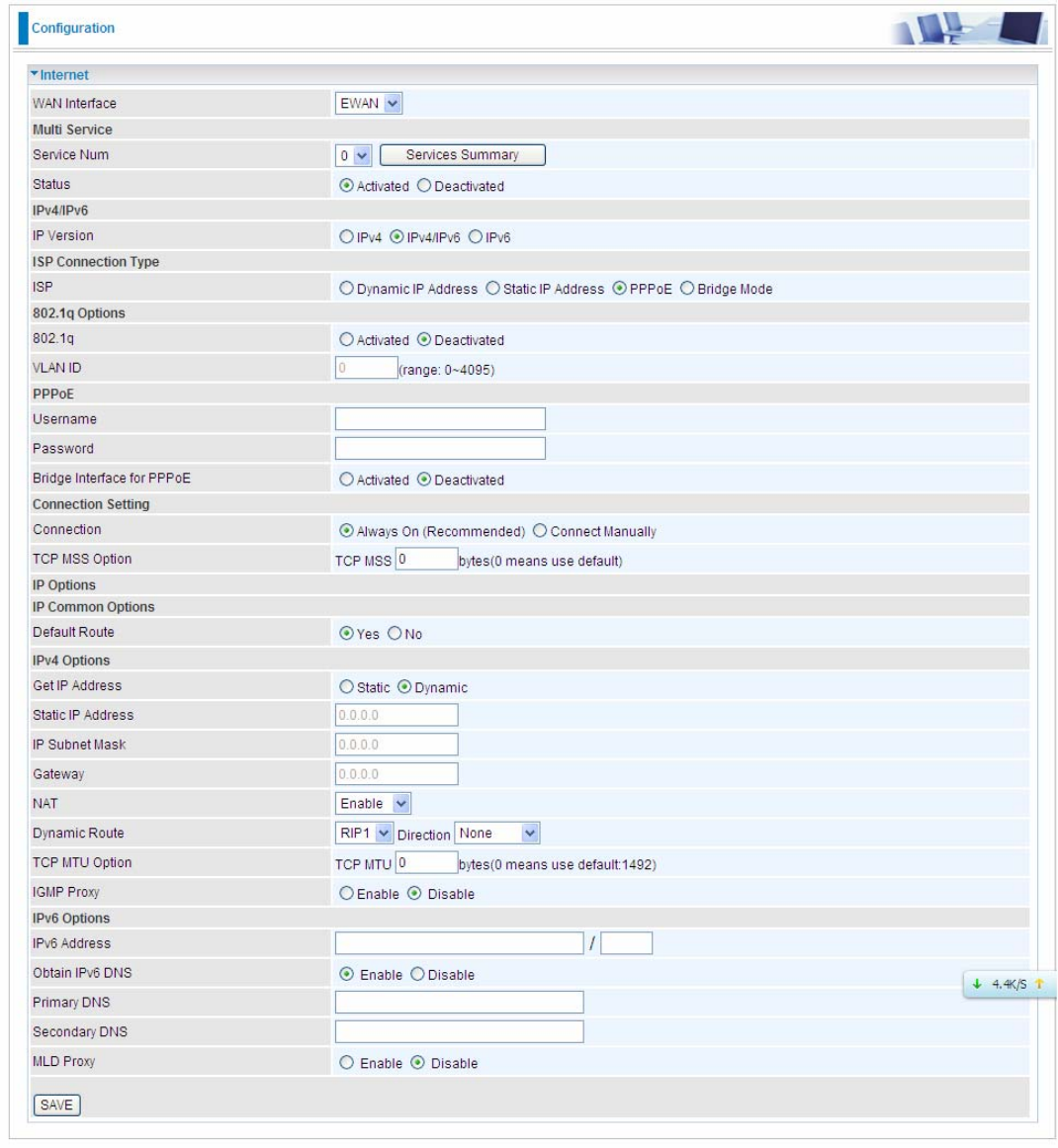
53
EWAN
(7600NXL)
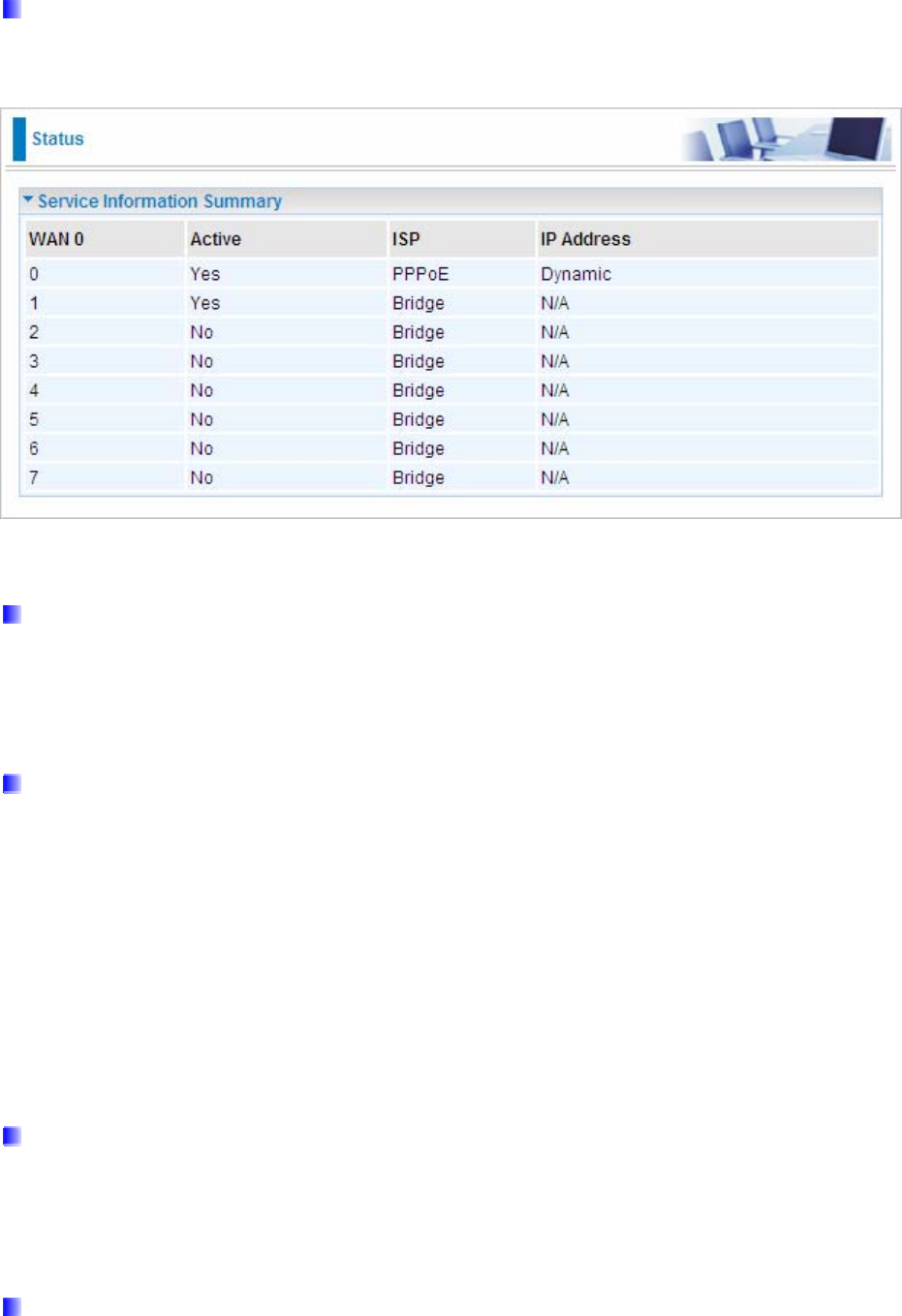
54
Multi Service (7600NXL only)
Service Num: The index to mark the EWAN interface of different ISP type, ranging from 0-7.
Service Summary: The diagram for view of service information.
Status: Select whether to enable the service.
IPv4/IPv6
IP version: choose IPv4, IPv4/IPv6, IPv6 based on users’ environment.
Here we take IPv4/IPv6 for example, when you just choose IPv4 or IPv6, you can just get information from the
following listed parameters.
ISP Connection Type:
ISP: Select the encapsulation type your ISP uses.
Dynamic IP: Select this option if your ISP provides you an IP address automatically. This option is
typically used for Cable services. Please enter the Dynamic IP information accordingly.
Static IP: Select this option to set static IP information. You will need to enter in the Connection type, IP
address, subnet mask, and gateway address, provided to you by your ISP. Each IP address entered in
the fields must be in the appropriate IP form, which is four IP octets separated by a dot (xx.xx.xx.xx). The
Router will not accept the IP address if it is not in this format.
PPPoE: Select this option if your ISP requires you to use a PPPoE connection.
Bridge: Select this mode if you want to use this device as an OSI layer 2 device like a switch.
802.1q Options
802.1q: Enter the user name exactly as your ISP assigned.
VLAN ID: It is a parameter to specify the VLAN which the frame belongs. Enter the VLAN ID identification,
tagged: 0-4095.
PPPoE
Username: Enter the user name exactly as your ISP assigned.
Password: Enter the password associated with the user name above.
Bridge Interface for PPPoE: When “Activated”, the device will gain WAN IP from your ISP with the PPPoE
account. But if your PC is connected to the router working as a DHCP client, in this mode, the device acts as a
NAT router; while if you dial up with the account within your PC, the device will then work as a bridge forwarding
the PPPoE information to the PPPoE server and send the response to your PC, thus your PC gets a WAN IP

55
working in the internet.
Connection Setting
Connection:
Always On: Click on Always On to establish a PPPoE session during start up and to automatically
re-establish the PPPoE session when disconnected by the ISP.
Connect Manually: Select Connect Manually when you don't want the connection up all the time.
TCP MSS Option: Enter the TCP Maximum Segment Size (MSS).
IP Options
Default Route: Select Yes to use this interface as default route interface.
IPv4 options:
Get IP Address: Choose Static or Dynamic
Static IP Address: If Static is selected in the above field, please enter the specific IP address you get from ISP
and the following IP subnet mask and gateway address.
IP Subnet Mask: The default is 0.0.0.0. User can change it to other such as 255.255.255.0.Type the subnet
mask assigned to you by your ISP (if given).
Gateway: Enter the specific gateway IP address you get from ISP.
NAT: Select Enable if you use this router to hold a group of PCs to get access to the internet.
Dynamic Route:
RIP Version: (Routing Information protocol) Select this option to specify the RIP version, including RIP-1,
RIP-2.
RIP Direction: Select this option to specify the RIP direction.
None is for disabling the RIP function.
Both means the router will periodically send routing information and accept routing information then
incorporate into routing table.
IN only means the router will only accept but will not send RIP packet.
OUT only means the router will only send but will not accept RIP packet.
TCP MTU Option: Maximum Transmission Unit, the maximum is 1500.
IGMP Proxy: IGMP (Internet Group Multicast Protocol) is a network-layer protocol used to establish
membership in a Multicast group. Choose whether enable IGMP proxy.
IPv6 options (only when choose IPv4/IPv6 or just IPv6 in IP version field above):
IPv6 Address: Type the WAN IPv6 address from your ISP.
Obtain IPv6 DNS: Choose if you want to obtain DNS automatically.
Primary/Secondary: if you choose Disable in the Obtain IPv6 DNS field, please type the exactly primary and
secondary DNS.
MLD Proxy: MLD (Multicast Listener Discovery Protocol) is to IPv6 just as IGMP to IPv4. It is a Multicast
Management protocol for IPv6 multicast packets.
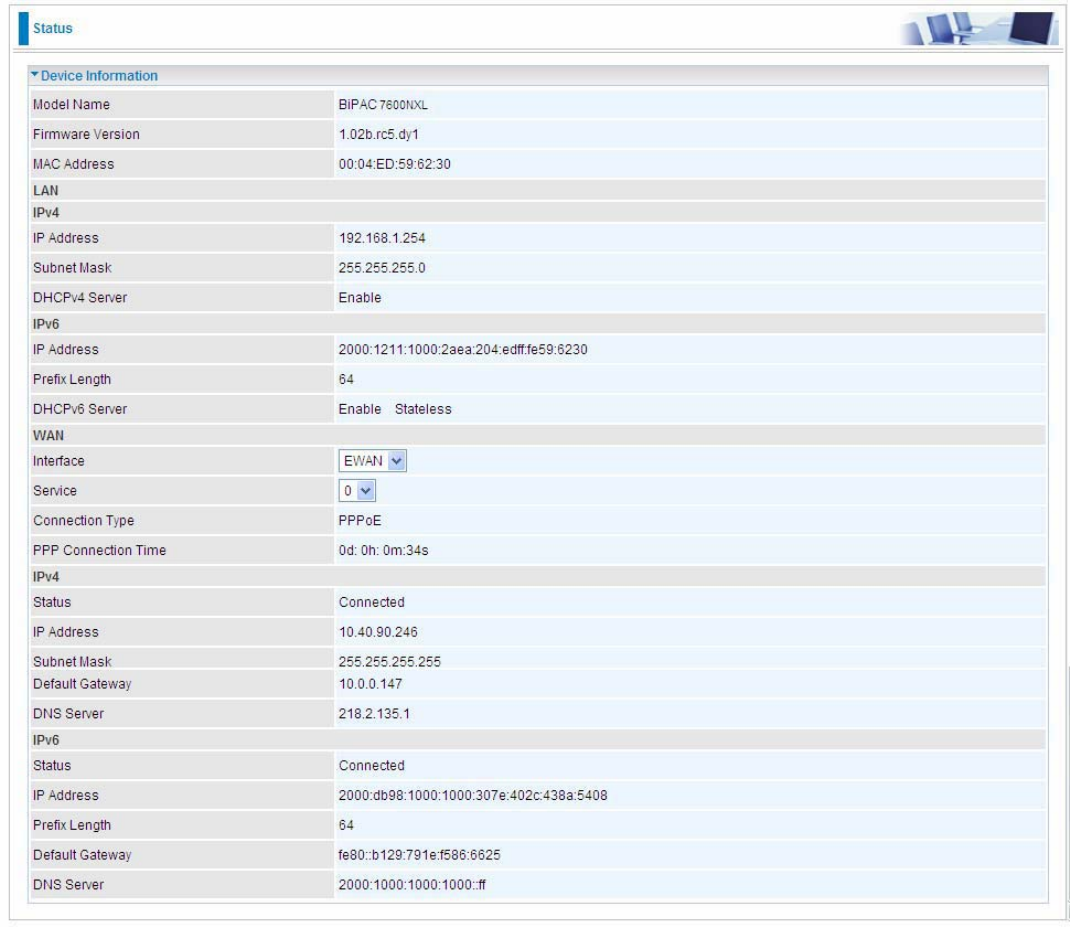
56
When router’s Internet configuration is finished successfully, you can go to status to get the connection
information.
(7600NXL)
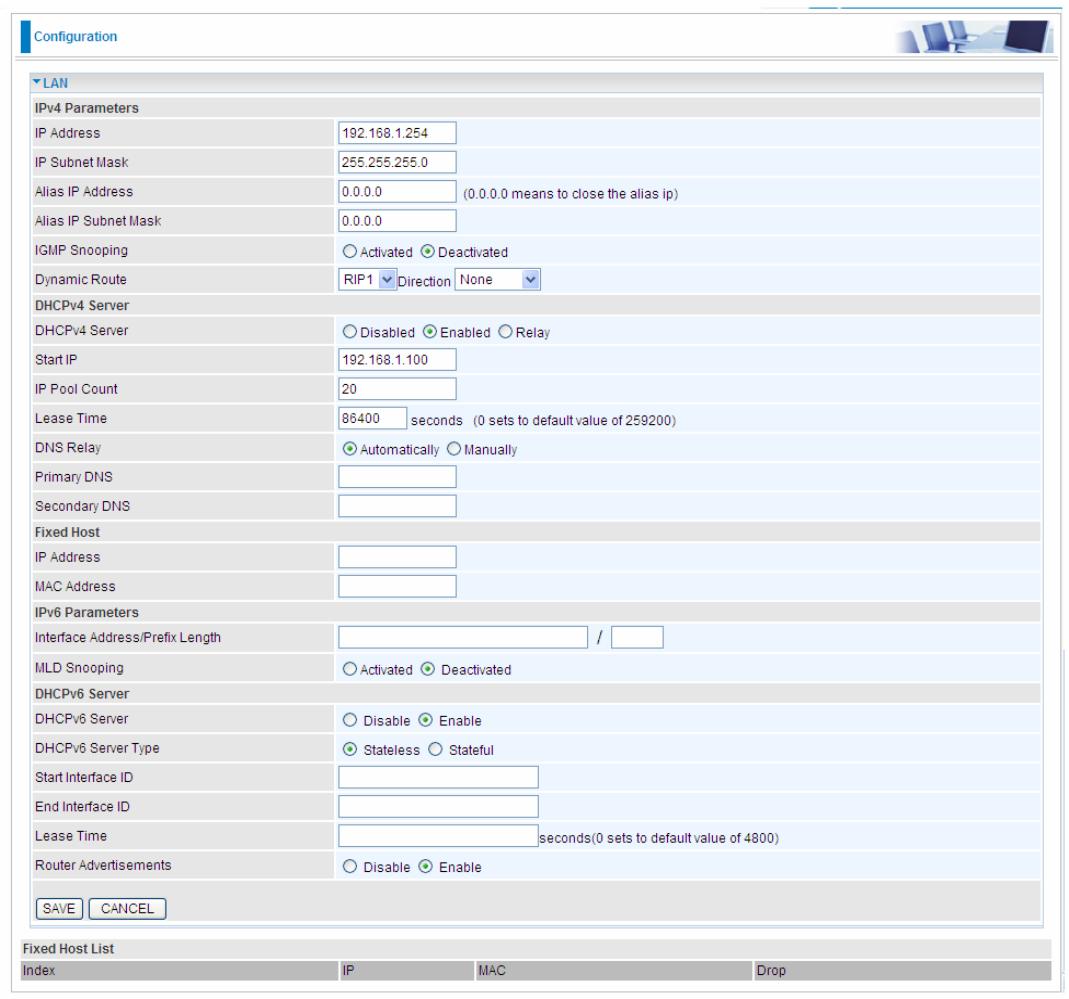
57
5.4.1.2 LAN
A Local Area Network (LAN) is a shared communication system to which many computers are attached and is
limited to the immediate area, usually the same building or floor of a building.
IPv6
The IPv6 address composes of two parts, thus, the prefix and the interface ID.
There are two ways to dynamically configure IPv6 address on hosts. One is statefull configuration, for example
using DHCPv6 (which resembles its counterpart DHCP in IPv4.) In the stateful autoconfiguration model, hosts
obtain interface addresses and/or configuration information and parameters from a DHCPv6 server. The Server
maintains a database that keeps track of which addresses have been assigned to which hosts.
The second way is stateless configuration. Stateless auto-configuration requires no manual configuration of
hosts, minimal (if any) configuration of routers, and no additional servers. The stateless mechanism allows a
host to generate its own addresses using a combination of locally available information (MAC address) and
information (prefix) advertised by routers. Routers advertise prefixes that identify the subnet(s) associated with
a link, while hosts generate an "interface identifier" that uniquely identifies an interface on a subnet. An address
is formed by combining the two. When using stateless configuration, you needn’t configure anything on the
client.

58
IPv4 Parameters
IP Address: Enter the IP address of Router in dotted decimal notation, for example, 192.168.1.254 (factory
default).
IP Subnet Mask: The default is 255.255.255.0. User can change it to other such as 255.255.255.128.
Alias IP Address: This is for local networks virtual IP interface. Specify an IP address on this virtual interface.
Alias IP Subnet Mask: Specify a subnet mask on this virtual interface.
IGMP Snooping: Select Activated to enable IGMP Snooping function, Without IGMP snooping, multicast
traffic is treated in the same manner as broadcast traffic - that is, it is forwarded to all ports. With IGMP snooping,
multicast traffic of a group is only forwarded to ports that have members of that group.
Dynamic Route: Select the RIP version from RIP1 or RIP2B.
DHCPv4 Server
DHCP (Dynamic Host Configuration Protocol) allows individual clients to obtain TCP/IP configuration at start-up
from a server.
DHCPv4 Server: If set to Enabled, your BiPAC 7600NX(L) can assign IP addresses, default gateway and DNS
servers to the DHCP client.
If set to Disabled, the DHCP server will be disabled.
If set to Relay, the BiPAC 7600NX(L) acts as a surrogate DHCP server and relays DHCP requests and
responses between the remote server and the clients. Enter the IP address of the actual, remote DHCP
server in the Remote DHCP Server field in this case.
When DHCP is used, the following items need to be set.
Start IP: This field specifies the first of the contiguous addresses in the IP address pool.
IP Pool Count: This field specifies the count of the IP address pool.
Lease Time: The current lease time of client.
DNS Relay Select Automatically obtained or Manually set (if selected. Please set the exactly information). If you
set Static IP in the ISP Connection Type field, then select Manually here and set the specific DNS information.
Primary DNS Server: Enter the IP addresses of the DNS servers. The DNS servers are passed to the DHCP
clients along with the IP address and the subnet mask.
Secondary DNS Server: Enter the IP addresses of the DNS servers. The DNS servers are passed to the
DHCP clients along with the IP address and the subnet mask.
Fixed Host
In this field, users can map the specific IP (must in the DHCP IP pool) for some specific MAC, and this
information can be listed in the following table.
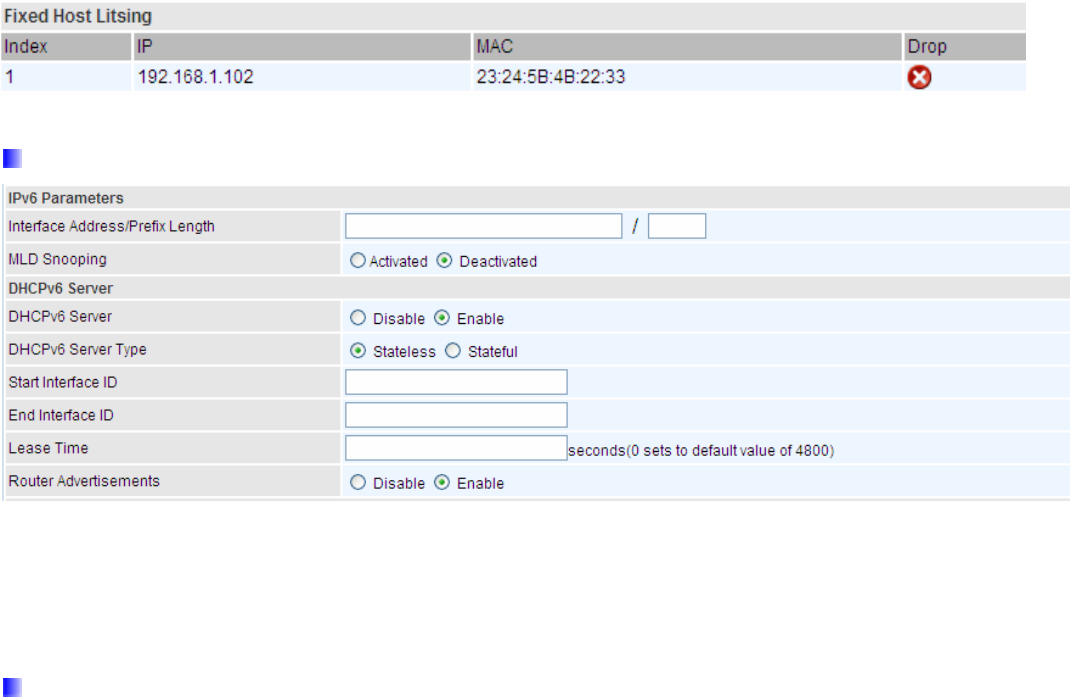
59
IP Address: Enter the specific IP. For example: 192.168.1.110.
MAC Address: Enter the responding MAC. For example: 00:0A:F7:45:6D:ED
When added, you can see the ones listed as showed below:
IPv6 parameters
Interface Address / Prefix Length: enter the static LAN IPv6 address, we suggest leave the field empty
because when setted wrong, it will result in LAN devices not being able to access other IPv6 device through
internet. Router will take the same WAN’s prefix to LAN side if the field is empty.
MLD Snooping: Similar to IGMP Snooping, but applicable for IPv6.
DHCPv6 Server
DHCPv6 Server: Check whether to enable DHCPv6 server.
DHCPv6 Server Type: Select Stateless or Stateful. When DHCPv6 is enabled, this parameter is available.
Stateless: If selected, the PCs in LAN are configured through RA mode, thus, the PCs in LAN are
configured through RA mode, to obtain the prefix message and generate an address using a
combination of locally available information (MAC address) and information (prefix) advertised by
routers, but they can obtain such information like DNS from DHCPv6 Server.
Stateful: If selected, the PCs in LAN will be configured like in IPv4 mode, thus obtain addresses and
DNS information from DHCPv6 server.
Start interface ID: enter the start interface ID. The IPv6 address composed of two parts, thus, the prefix and the
interface ID. Interface is like the Host ID compared to IPv4.
End interface ID: enter the end interface ID.
Leased Time (hour): the leased time, similar to leased time in DHCPv4, is a time limit assigned to clients, when
expires, the assigned ID will be recycled and reassigned.
Issue Router Advertisement: Check whether to enable issue Router Advertisement feature. It is to send
Router Advertisement messages periodically. Router will multicast the v6 Prefix information (similar to v4
network number 192.168.1.0) to all LAN devices if the field is enabled. We suggest enabling this field.

60
5.4.1.3 Wireless
This section introduces the wireless LAN and some basic configurations. Wireless LANs can be as complex as
a number of computers with wireless LAN cards communicating through access points which bridge network
traffic to the wired LAN.
(By default, 4 SSIDs are in use. But to simplify the illustration, we only enable 1 SSID. )

61
Access Point Settings
Access Point: Default setting is set to Activated. If you want to close the wireless interface, select
Deactivated.
Channel ID: The range of radio frequencies used by IEEE 802.11b/g/n wireless devices is called a channel.
There are Regulation Domains and Channel ID in this field. The Channel ID will be different based on
Regulation Domains. Select a channel from the drop-down list box.
Beacon interval: The Beacon Interval value indicates the frequency interval of the beacon. Enter a value
between 20 and 1000. A beacon is a packet broadcast by the Router to synchronize the wireless network.
RTS/CTS Threshold: The RTS (Request To Send) threshold (number of bytes) for enabling RTS/CTS
handshake. Data with its frame size larger than this value will perform the RTS/CTS handshake. Enter a value
between 1500 and 2347.
Fragmentation Threshold: The threshold (number of bytes) for the fragmentation boundary for directed
messages. It is the maximum data fragment size that can be sent. Enter a value between 256 and 2346, even
number only.
DTIM: This value, between 1 and 255, indicates the interval of the Delivery Traffic Indication Message (DTIM).
TX Power: The transmission power of the antennas, ranging from 1-100, the higher the more powerful of the
transmission performance.
Wireless Mode: The default setting is 802.11b+g+n (Mixed mode). If you do not know or have both 11g and
11b devices in your network, then keep the default in mixed mode. From the drop-down manual, you can select
802.11g if you have only 11g card. If you have only 11b card, then select 802.11b and if you only have 802.11n
then select 802.11n.
11n Settings
Channel Bandwidth: Select either 20 MHz or 20/40 MHz for the channel bandwidth. The wider the Channel
bandwidth the better the performance will be.
Guard Interval: Select either 400nsec or 800nsec for the guard interval. The guard interval is here to ensure
that data transmission do not interfere with each other. It also prevents propagation delays, echoing and
reflections. The shorter the Guard Interval, the better the performance will be. We recommend users to select
Auto.
MCS: There are options 0~15 and AUTO to select for the Modulation and Coding Scheme. We recommend
users selecting AUTO.
SSID Settings
SSID Index: Select how many SSIDs you want to lay out. A total of 4 is in list. By default 4 SSIDs are in use.
SSID: The SSID is the unique name of a wireless access point (AP) to be distinguished from another. For
security propose, change the default wlan-ap to a unique ID name to the AP which is already built-in to the
router’s wireless interface. Make sure your wireless clients have exactly the SSID as the device, in order to get
connected to your network.
Broadcast SSID: Select Yes to make the SSID visible so a station can obtain the SSID through passive
scanning. Select No to hide the SSID in so a station cannot obtain the SSID through passive scanning.

62
WPS Settings
WPS (Wi-Fi Protected Setup) feature is a standard protocol created by Wi-Fi Alliance. This feature greatly
simplifies the steps needed to create a Wi-Fi networks for a residential or an office setting. WPS supports 2
types of configuration methods which are commonly known among consumers: PIN Method & PBC Method.
WPS State: Display whether the WPS is configured or unconfigured.
WPS Mode: Select the mode which to start WPS, choose between PIN Code and PBC (Push Button).
Selecting Pin Code mode will require you to know the enrollee PIN code.
To future understand the two modes of configuration; please refer to the following Wi-Fi Protected Setup.
Wi-Fi Protected Setup
PIN Method: Configure AP as Registrar
1. Jot down the client’s Pin (eg. 04640776).
2. Enter the Enrollee(Client) PIN code and then press Start WPS.
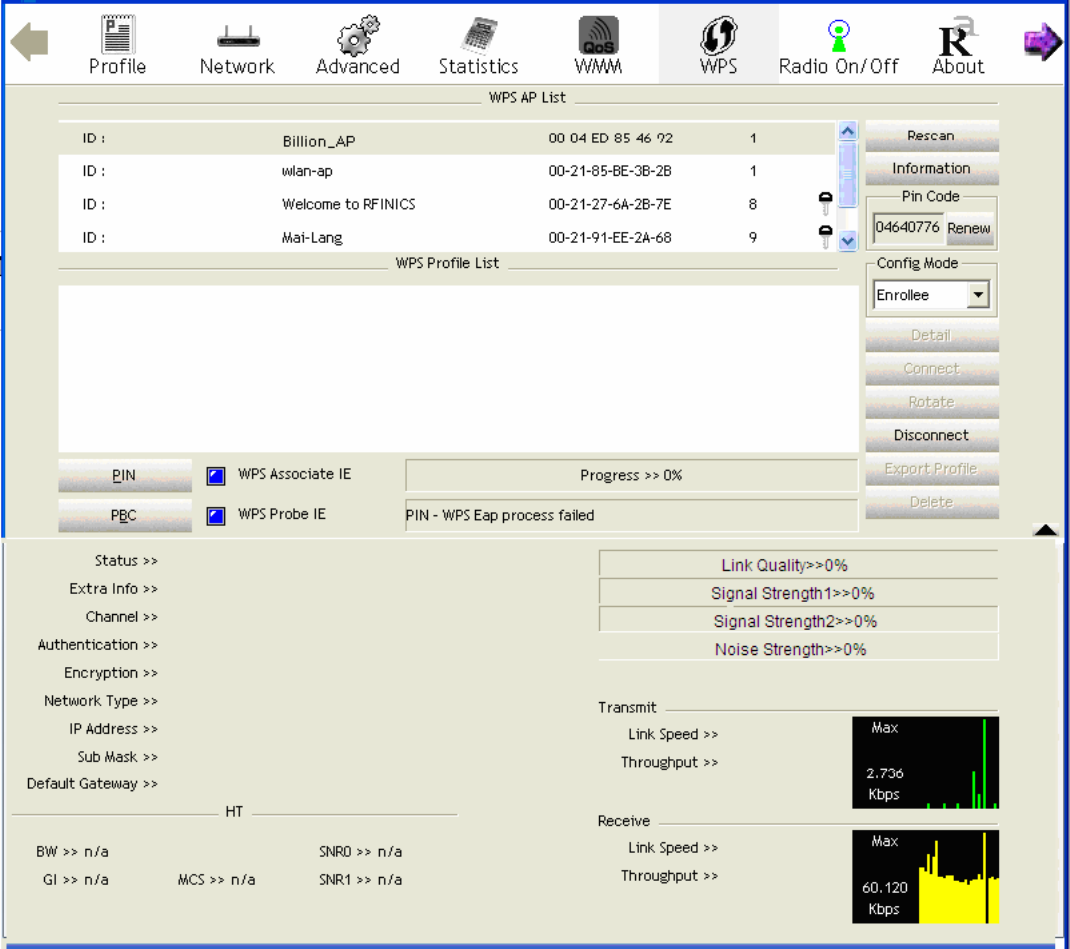
63
3. Launch the wireless client’s WPS utility (eg. Ralink Utility). Set the Config Mode as Enrollee, press the WPS
button on the top bar, select the AP (eg. Billion_AP) from the WPS AP List column. Then press the PIN button
located on the middle left of the page to run the scan.
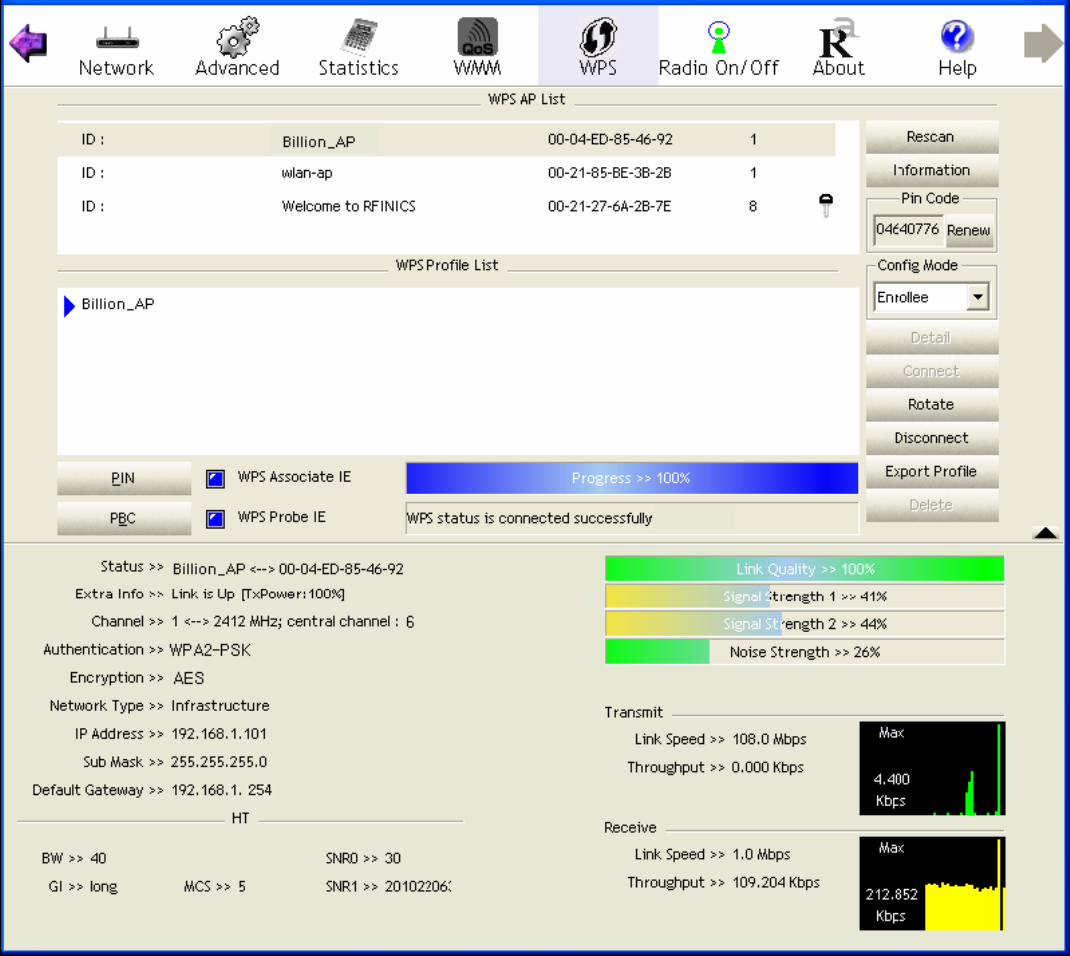
64
4. The client’s SSID and security setting will now be configured to match the SSID and security setting of the
registrar (router).
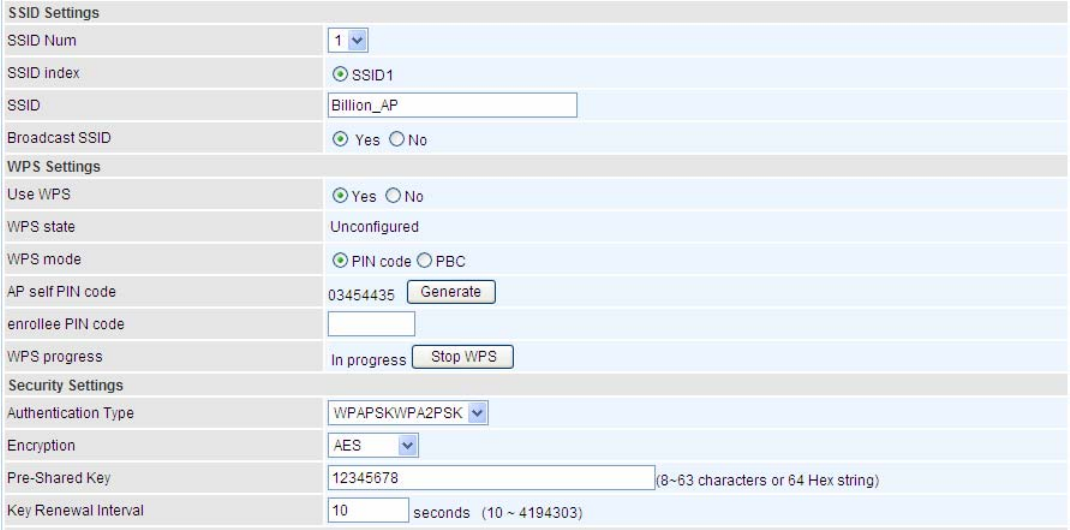
65
PIN Method: Configure AP as Enrollee
1. Jot down the WPS PIN (eg. 03454435).Press Start WPS.
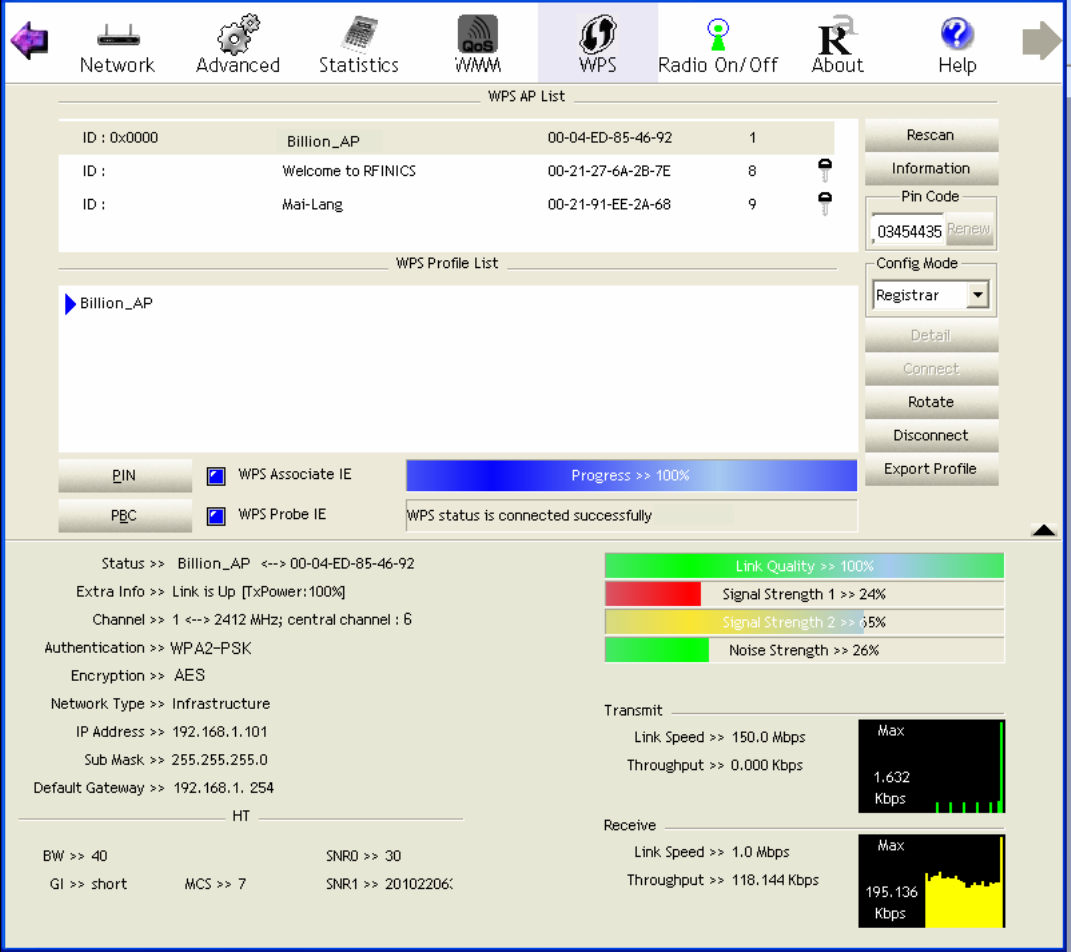
66
2. Launch the wireless client’s WPS utility (eg. Ralink Utility). Set the Config Mode as Registrar. Enter the PIN
number in the PIN Code column then choose the correct AP (eg. Billion_AP) from the WPS AP List before
pressing the PIN button to run the scan.
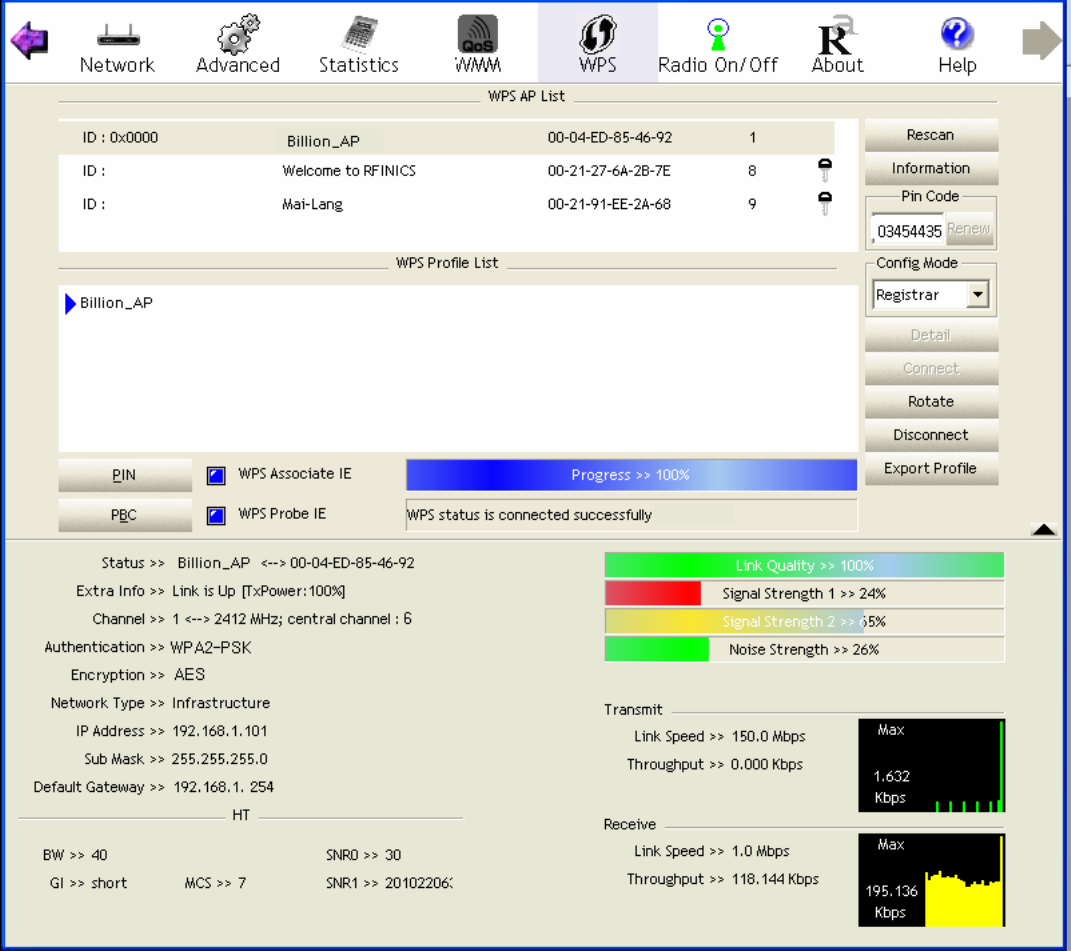
67
3. The router’s (AP’s) SSID and security setting will now be configured to match the SSID and security setting of
the registrar (client).
4. Now to make sure that the setup is correctly done, cross check to see if the SSID and the security setting of
the registrar setting match with the parameters found on both Wireless Configuration and Wireless Security
Configuration page.
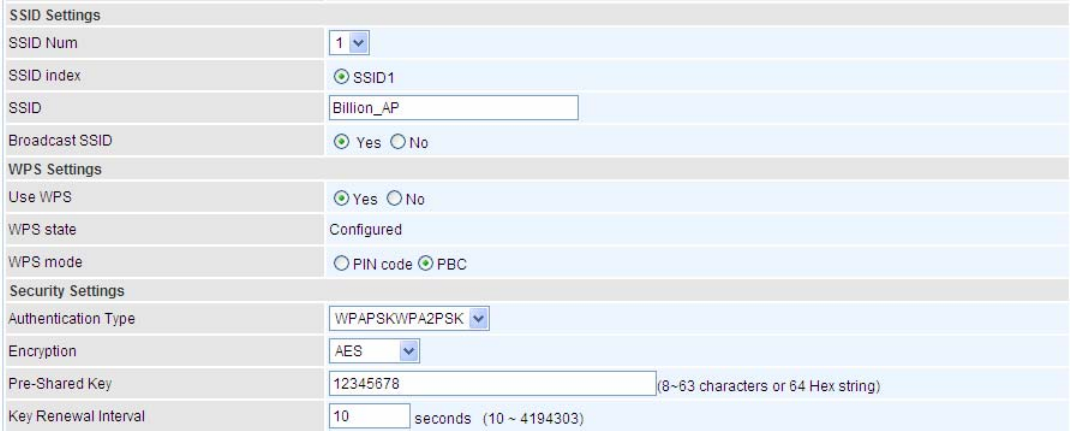
68
PBC Method:
1. Press the PBC radio button, Then Start WPS.
2. Launch the wireless client’s WPS Utility (eg. Ralink Utility). Set the Config Mode as Enrollee. Then press the
WPS button and choose the correct AP (eg. Billion_AP) from the WPS AP List section before pressing the PBC
button to run the scan.
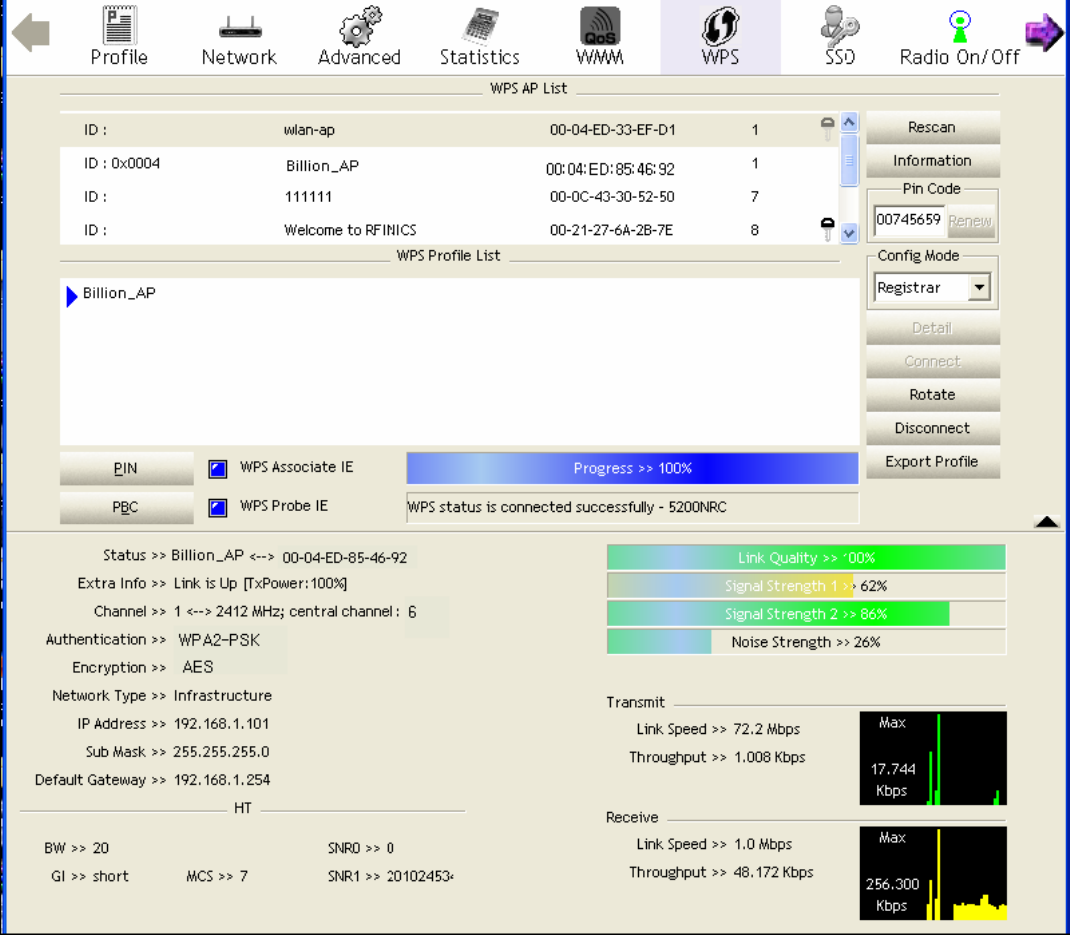
69
3. When the PBC button is pushed, a wireless communication will be established between your router and the
PC. The client’s SSID and security setting will now be configured to match the SSID and security setting of the
router.
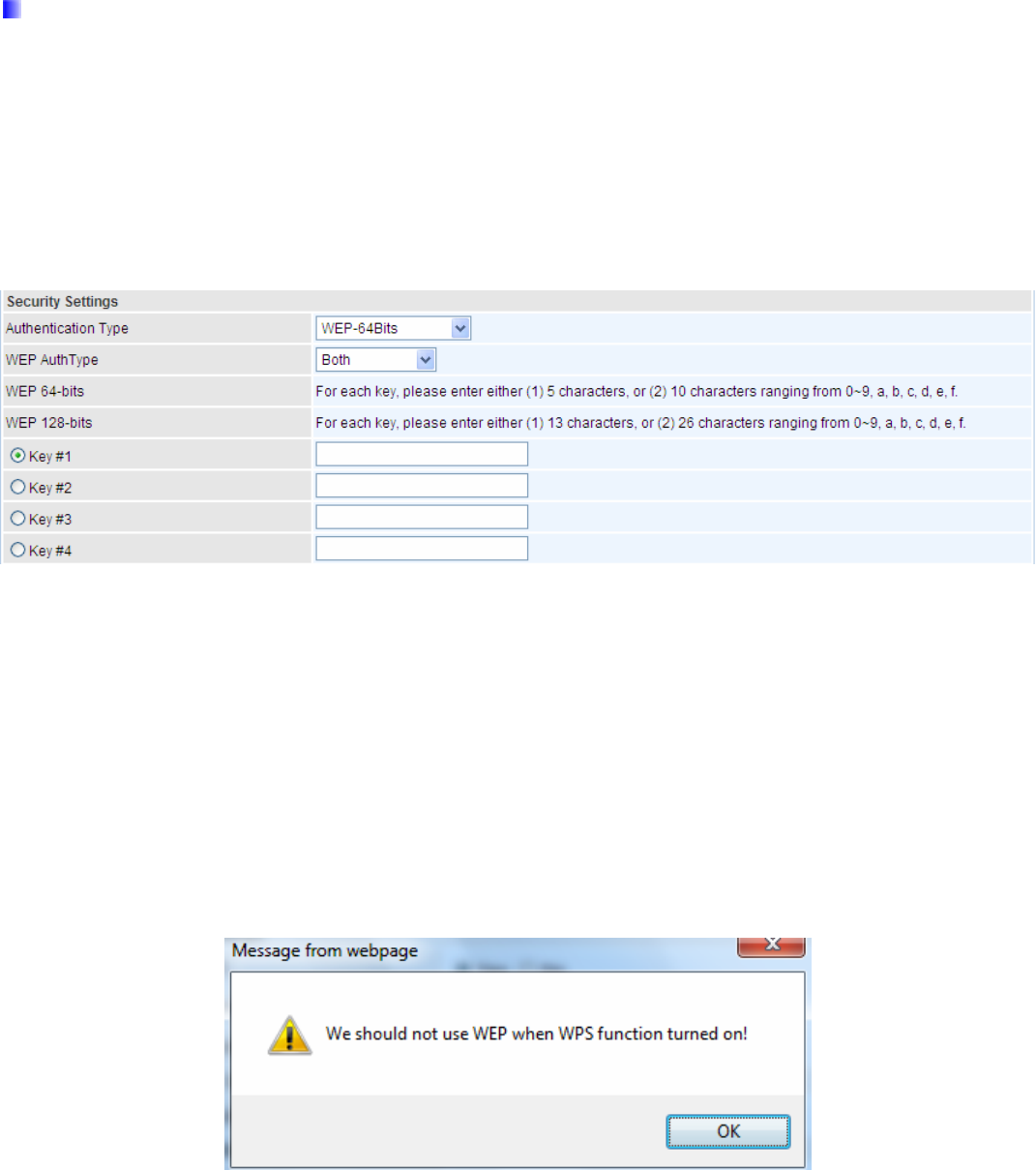
70
Security Settings
Authentication Type: You can disable or enable wireless security for protecting wireless network. The default
type of wireless security is OPEN and to allow all wireless stations to communicate with the access points
without any data encryption.
To prevent unauthorized wireless stations from accessing data transmitted over the network, the router offers
secure data encryption, known as WEP and WPA.
There are five alternatives to select from: WEP-64Bits, WEP-128Bits, WPA-PSK, WPA2-PSK, WPA/WPA2-PSK.
If you require high security for transmissions, please select WPA-PSK, WPA2-PSK or WPA/WPA2-PSK.
WEP
WEP AuthType: WEP authentication method, there are two methods of authentication used, Open System
authentication (OPENWEB) and Share Key authentication (SHAREDWEB). We suggest you select
OPENWEB.
Key 1 to Key 4: Enter the key to encrypt wireless data. To allow encrypted data transmission, the WEP
Encryption Key values on all wireless stations must be the same as the router. There are four keys for your
selection. The input format is in HEX style, 5 and 13 HEX codes are required for 64-bitWEP and 128-bitWEP
respectively.
If you chose WEP-64Bbits, then enter any 5 ASCII characters or 10 hexadecimal characters ("0-9", "A-F").
If you chose WEP-128Bits, then enter 13 ASCII characters or 26 hexadecimal characters ("0-9", "A-F").
You must configure all four keys, but only one key can be activated at any one time. The default key is key 1.
Note: When you enable WPS function, this WEP function will be invalid. And if you select one of WEP-64Bits/
WEP-128Bits, the following prompt box will appear to notice you.
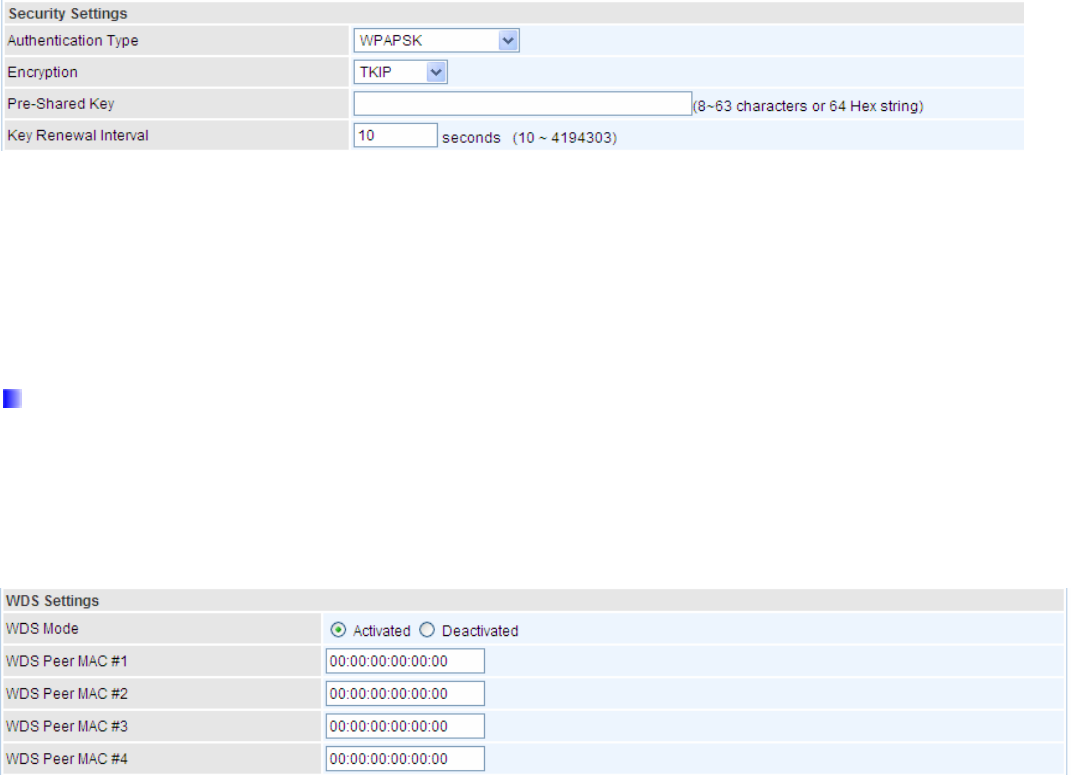
71
WPA-PSK & WPA2-PSK
Encryption: TKIP (Temporal Key Integrity Protocol) or AES (Advanced Encryption System) utilizes a stronger
encryption method and incorporates Message Integrity Code (MIC) to provide protection against hackers.
Pre-Shared key: The key for network authentication. The input format should be 8-63 ASKII characters or 64
hexadecimal characters
Key Renewal Interval: The time interval for changing the security key automatically between wireless client
and AP.
WDS Settings
WDS (Wireless distributed system) is a wireless access point mode that enables wireless link and
communication with other access point. It is easy to be installed, just define the peer’s MAC of the connected
AP.
WDS Mode: select Activated to enable WDS feature and Deactivated to disable this feature.
MAC Address: Enter the AP MAC addresses (in XX:XX:XX:XX:XX:XX format) of the peer connected AP.
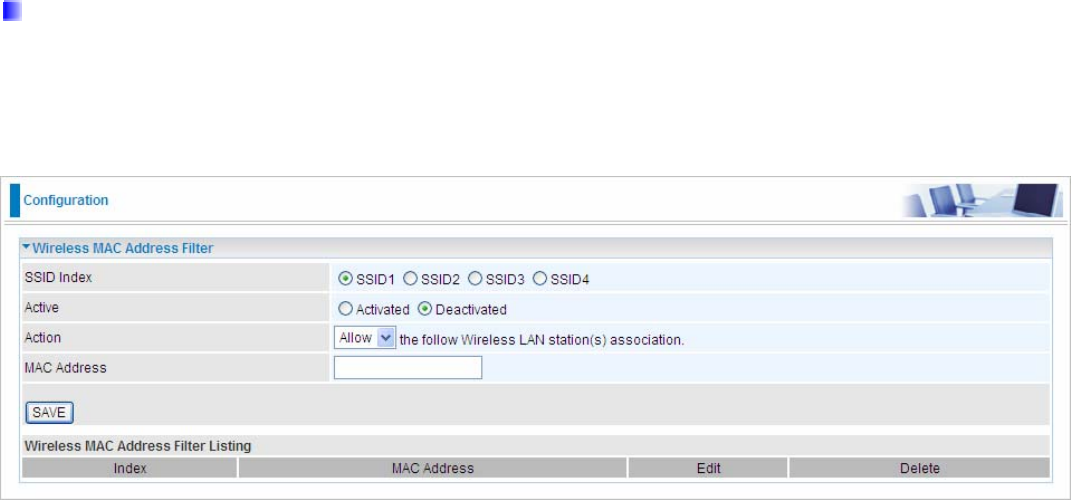
72
Wireless MAC Address Filter
The MAC filter screen allows you to configure the router to give exclusive access to up to 8 devices (Allow
Association) or exclude up to 8 devices from accessing the router (Deny Association). Every Ethernet device
has a unique MAC (Media Access Control) address. The MAC address is assigned at the factory and consists of
six pairs of hexadecimal characters, for example, 00:AA:BB:00:00:02. You need to know the MAC address of
the devices to configure this screen.
SSID Index: Select the targeted SSID you want the MAC filter rules to apply to.
Active: Select Activated to enable MAC address filtering.
Action: Define the filter action for the list of MAC addresses in the MAC address filter table.
Select Deny to block access to the AP, MAC addresses not listed will be allowed to access the router. Select
Allow to permit access to the router, MAC addresses not listed will be denied access to the router.
MAC Address: Enter the MAC addresses (in XX:XX:XX:XX:XX:XX format) of the wireless station that are
allowed or denied access to the specified in these address fields.
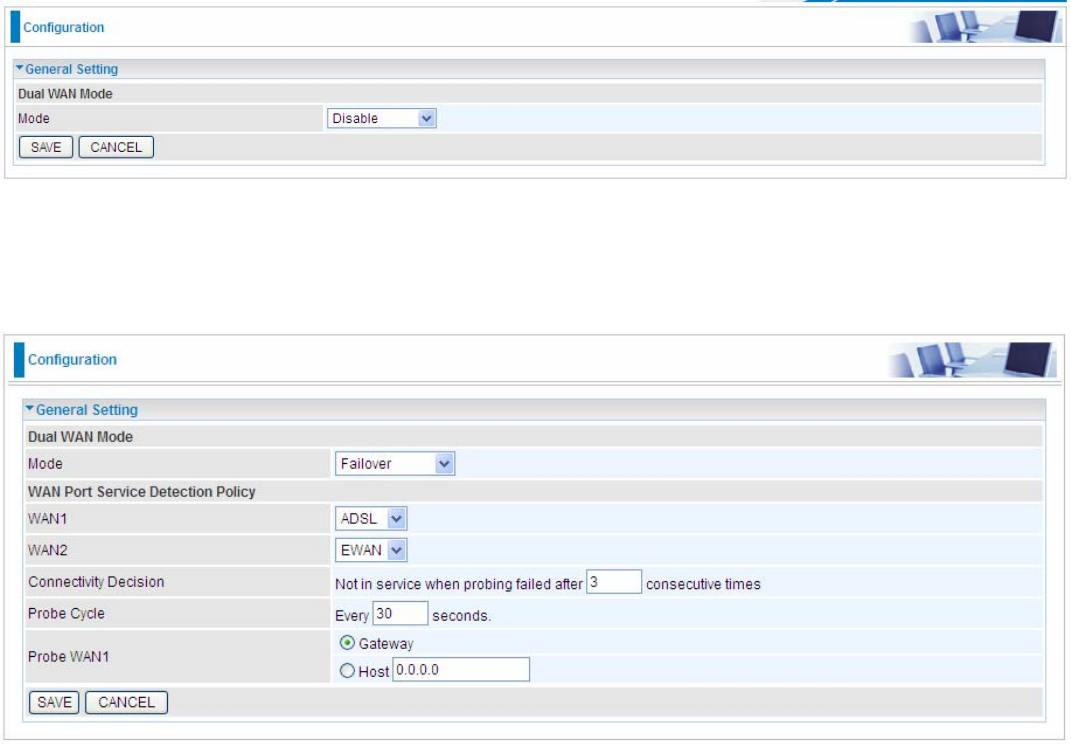
73
5.5 Dual WAN
Dual WAN is specially designed to offer users failover/fallback or Load Balance feature.
Auto failover/failback is to ensure an always-on internet connection. Users can set a WAN1 (main WAN) and
WAN 2 (backup WAN), and when WAN1 fails, it will switch to WAN2, and when WAN1 restores, it will switch to
WAN1 again.
Load balance provides optimal bandwidth sharing for multiple PCs on your network, or allows maximum
reliability with network redundancy. Load balance supported by BiPAC 7600NX(L) balance network bandwidth
for network traffic through two WAN connections, ideal for small-to-medium business that requires increased
bandwidth, network scalability, and resilience for mission-critical network and internet applications.
5.5.1 General Setting
Select Failover to enable the failover/failback feature or Load Balance to make the router work in load balance
mode.
Failover
WAN Port Service Detection Policy
WAN1: Select “ADSL”, or “EWAN” for WAN1 (The main WAN).
WAN2: Select the “EWAN” for WAN2 as backup port if you select “ADSL” as WAN1.
Connectivity Decision: Set how many times of probing failure to switch to backup port.
Probe Cycle: Set the time duration for the Probe Cycle to determine when the router will switch to the backup
connection (backup port) once the main connection (main port) fails. For example, when set to 30 seconds, the
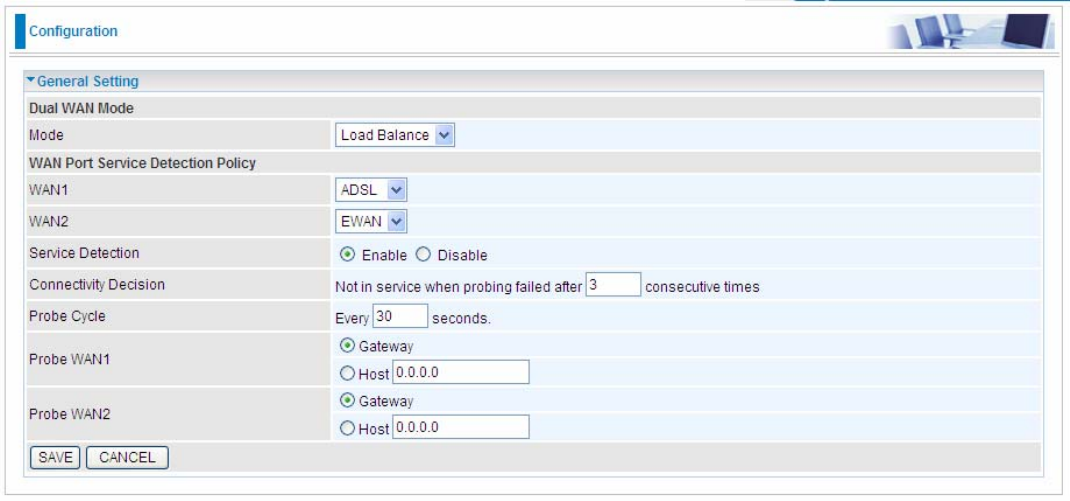
74
probe will be conducted every 30 seconds.
Note:
1) The time set is for each probe cycle, but the decision to change to the backup port is determined by Probe
Cycle multiplied by connection Decision amount (e.g. From the image above it will be 30 seconds multiplied
by 3 consecutive fails, the router will determine failover to WAN2 (backup port)).
2).The failback setting follow the same decision policy as the failover. For example, according to settings above
in the screenshot, the connection probe will be carried out every 30 seconds, and 3 consecutive times of probe
success is found, the router will determine failback to WAN1 (main WAN).
Probe WAN 1: Choose the probe policy, to probe gateway or host (users decide themselves)
Gateway: It will send ping packets to gateway of Wan1 interface and wait for response from it in every
“Probe Cycle” to check the connectivity of the gateway of WAN1 interface.
Host: It will send ping packets to specific host and wait for response in every “Probe Cycle”. The host
must be an IP address.
Load Balance (7600NX only)
WAN Port Service Detection Policy
WAN1: Select “ADSL”, or “EWAN” for WAN1 (The main WAN).
WAN2: Select the “EWAN” for WAN2 as backup port if you select “ADSL” as WAN1.
Connectivity Decision: Set how many times of probing failure to switch to backup port.
Probe Cycle: Set the time duration for the Probe Cycle to determine when the router will switch to the backup
connection (backup port) once the main connection (main port) fails. For example, when set to 30 seconds, the
probe will be conducted every 30 seconds.
Note:
1) The time set is for each probe cycle, but the decision to change to the backup port is determined by Probe
Cycle multiplied by connection Decision amount (e.g. From the image above it will be 30 seconds multiplied